Lou’s Views
News & Views / November Edition

Calendar of Events –
NA
 Discover a wide range of things to do in the Brunswick Islands for an experience that goes beyond the beach.
Discover a wide range of things to do in the Brunswick Islands for an experience that goes beyond the beach.
For more information » click here.
Calendar of Events Island –

Turkey Trot
The Town of Holden Beach will hold its tenth annual Turkey Trot on Thanksgiving morning, November 28th at 8:00 am All individuals interested in participating should call 910.842.6488 to register. Please bring a canned food item to donate to the local food pantry.

Tree Lighting
Come one, Come all!
The Town of Holden Beach will hold its fifteenth annual Tree Lighting annual tree lighting ceremony on Thursday, December 5th at 6 pm, entertainment starts at 5:15 pm.

Gingerbread Creation Contest
The Town of Holden Beach will sponsor a gingerbread creation competition to be judged as part of our annual tree lighting event on December 5th. There will be two categories, one for businesses and one for individuals.

Reindeer Dash and Santa Saunter
Oh, what fun it is to… work off some Christmas cookies. The Town of Holden Beach will host a fun run/walk on Saturday, December 14th at 8:00am, starting at Town Hall. For those who wish to run the event, channel your inner reindeer and dress in your best reindeer attire (homemade is excellent). For those that want to move more like the jolly guy himself, dress in your best Santa attire and saunter through the course. The approximately 2-mile route will be starting your Saturday off with a little fitness and lots of fun!

Sandy Paws Dog Parade
Join us on Saturday, December 14th at 10:00 am outside the Town Hall Public Assembly for our tenth annual Sandy Paws Dog Parade. We will do a short walk around the block and back to the picnic shelter where you can have you dog’s picture taken with Santa. There is no fee but we will be accepting donations of pet supplies for the animal shelter.

The Chapel Choir Christmas Musical Performance
The Holden Beach Choir is preparing for its fourth annual Christmas concert with a live orchestra. On Sunday December 15th at 7:00pm, the choir will present the musical The Journey of Hope, accompanied by the Chamber Orchestra.

Parks & Recreation / Programs & Events
For more information » click here
Reminders –
 News from Town of Holden Beach
News from Town of Holden Beach
The town sends out emails of events, news, agendas, notifications, and emergency information. If you would like to be added to their mailing list, please go to their web site to complete your subscription to the Holden Beach E-Newsletter.
For more information » click here

Paid Parking
Paid parking will be enforced in all Holden Beach designated parking areas. It will be enforced from 9:00 a.m. – 5:00 p.m. daily, with free parking before and after that time. All parking will use license plates for verification.
Visit https://hbtownhall.com/paid-parking for more information and to view a table with authorized parking areas.
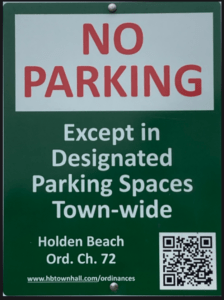

Pets on the Beach Strand
Pets – Chapter 90 / Animals / 90.20
Effective September 10th
- Pets allowed back on the beach strand during the hours of 9:00am through 5:00pm
- Dog’s need to be on a leash
- Owner’s need to clean up after their animals

Solid Waste Pick-Up Schedule
GFL Environmental change in service, October through May trash pickup will be once a week. This year September 28th will be the the last Saturday trash pick-up until June. Trash collection will go back to Tuesdays only.
Please note:
. • Trash carts must be at the street by 6:00 a.m. on the pickup day
. • BAG the trash before putting it in the cart
. • Carts will be rolled back to the front of the house
GFL Refuse Collection Policy
GFL has recently notified all Brunswick County residents that they will no longer accept extra bags of refuse outside of the collection cart. This is not a new policy but is stricter enforcement of an existing policy. While in the past GFL drivers would at times make exceptions and take additional bags of refuse, the tremendous growth in housing within Brunswick County makes this practice cost prohibitive and causes drivers to fall behind schedule.
Solid Waste Pick-up Schedule –
starting October once a week
Recycling –
starting October every other week pick-up
 Yard Waste Service
Yard Waste Service
Yard debris is collected on the second (2nd) and fourth (4th) Fridays during the months of October, November, and December. Yard debris needs to be secured in a biodegradable bag (not plastic) or bundled in a maximum length not to exceed five (5) feet and fifty (50) pounds in weight. Each residence is allowed a total of ten (10) items, which can include a combination of bundles of brush and limbs meeting the required length and weight and/ or biodegradable bags. Picks-ups are not provided for vacant lots or construction sites.
Curbside Recycling – 2024
GFL Environmental is now offering curbside recycling for Town properties that desire to participate in the service. The service cost per cart is $106.88 annually paid in advance to the Town of Holden Beach. The service consists of a ninety-six (96) gallon cart that is emptied every other week during the months of October – May and weekly during the months of June – September.
Curbside Recycling Application » click here
Curbside Recycling Calendar » click here

Trash Can Requirements – Rental Properties
GFL Environmental – trash can requirements
Ordinance 07-13, Section 50.08
Rental properties have specific number of trash cans based on number of bedrooms.
* One extra trash can per every 2 bedrooms
..
§ 50.08 RENTAL HOMES.
(A) Rental homes, as defined in Chapter 157, that are rented as part of the summer rental season, are subject to high numbers of guests, resulting in abnormally large volumes of trash. This type of occupancy use presents a significantly higher impact than homes not used for summer rentals. In interest of public health and sanitation and environmental concerns, all rental home shall have a minimum of one trash can per two bedrooms. Homes with an odd number of bedrooms shall round up (for examples one to two bedrooms – one trash can; three to four bedrooms – two trash cans; five – six bedrooms – three trash cans, and the like).
Building Numbers
Ocean front homes are required to have house numbers visible from the beach strand.
Please call Planning and Inspections Department at 910.842.6080 with any questions.
§157.087 BUILDING NUMBERS.
(A) The correct street number shall be clearly visible from the street on all buildings. Numbers shall be block letters, not script, and of a color clearly in contrast with that of the building and shall be a minimum of six inches in height.
(B) Beach front buildings will also have clearly visible house numbers from the strand side meeting the above criteria on size, contrast, etc. Placement shall be on vertical column supporting deck(s) or deck roof on the primary structure. For buildings with a setback of over 300 feet from the first dune line, a vertical post shall be erected aside the walkway with house numbers affixed. In all cases the numbers must be clearly visible from the strand. Other placements may be acceptable with approval of the Building Inspector.
Upon Further Review –
 Topsail Island towns team to eradicate harmful beach vitex
Topsail Island towns team to eradicate harmful beach vitex
Topsail Island towns are banding together to dramatically reduce the presence of an invasive plant that chokes out native vegetation on oceanfront dunes. Beach vitex, a thick, woody vine that sheds its leaves seasonally, is growing on more than 170 properties spanning the three towns on the 26-mile-long barrier island. Those properties were identified in what has been described as a cursory, “windshield” survey conducted to give officials an idea of where and how much of the plant is on the island’s oceanfront dunes. “We know there’s more out there,” said Topsail Beach Assistant Town Manager Christina Burke. The survey provided enough information for that town, North Topsail Beach and Surf City to jointly apply for a North Carolina Coastal Storm Damage Mitigation Fund grant. In May, the North Carolina Department of Environmental Quality’s Division of Water Resources awarded those towns a collective $690,060.50, enough to cover half of the total projected cost of the first two years of what will be a four-year project. According to the interlocal agreement, the towns “will continue to work together to secure additional funding to carry the project out to completion.” Each town will be responsible for matching its portion of the grant. North Topsail Beach last week joined Surf City in adopting an interlocal agreement that sets the terms for the aptly named Topsail Island Vitex Eradication Project. Topsail Beach commissioners are expected to consider the agreement at their meeting Wednesday evening. If the board greenlights the agreement, a resolution to accept the grant funding will be put to a vote most likely next month, Burke said. The idea is to put out a request for proposal, or a formal document asking for contractor bids, by either December or January. Topsail Beach agreed to be the fiscal agent to administer the grant funds, which are the culmination of a partnership initiated by the Topsail Island Shoreline Protection Commission. The commission functions as a collaboration to preserve the beaches and surrounding waterways of the barrier island and is made up of elected officials and local government appointees from each town and Onslow and Pender counties. Commission members began a couple of years ago discussing the need for an island-wide project to tackle eradicating the invasive plant that has wound its way over and along oceanfront dunes in the Carolinas after being introduced to the Southeastern United States in the mid-1980s. But what was originally planted for ornamental purposes and sand dune stabilization escaped cultivation, crowding out sea oats, American beachgrass, seaside panicum and other native plants, ultimately threatening endangered loggerhead sea turtle nesting habitat, federally threatened seabeach amaranth and other rare plants and animals. The state initiated efforts in 2005 to document locations of beach vitex and control its spread by creating the NC Beach Vitex Task Force in February of that year. “Knowing it’s an invasive species and threatening to the dune system and the ecological system that we have here, the turtles, we decided to do something about it,” Burke said. Based on the survey, Topsail Beach has the most properties – 93 – where beach vitex is present. Surf City has 45. A total of 35 properties were noted to have the plant in North Topsail Beach. “That is just so incomplete still,” Burke said. Eradicating beach vitex can be a rather painstaking process, one that requires a scratch-and-dab method where the bark of a vine must be scratched off before an herbicide can be applied. Glyphosate, a systemic herbicide that blocks an enzyme essential for plant growth, is a chemical commonly used in killing beach vitex. Beach vitex usually requires a couple of treatment applications, after which the plant must be monitored to ensure it is dying back. Treatment must occur only in summer. “You have to kill it first and then you have to cut it out,” Burke explained. Precautions must be taken when removing dead beach vitex to ensure seeds do not fall from the vines onto the ground and recultivate. Treating the 93 properties in Topsail Beach alone is expected to cost an estimated $584,000. The Topsail Island Shoreline Protection Commission will provide up-to-date information on its website as the project moves forward and continue efforts to educate property owners about the pesky plant. Property owners will receive a waiver to sign off on that will the contractor to access individual lots to begin treatment, Burke said. “They see all this lush vegetation and they’re like, oh my gosh, look at my dune system, it’s great, it’s so healthy. I think with the education of vitex and how dangerous it is to the dune system, people are going to me more apt to allow us to come in,” she said. “We have people who call us that say, please put me on that list, I have vitex and I want to be part of this project so I think the attitude has changed with the education of vitex.”
Read more » click here
Beach Vitex Invades the Carolina Coast
Beach Vitex (Vitex rotundifolia) is a deciduous, woody vine that was introduced to the southeastern U.S. in the mid-80’s as an ornamental landscape plant as well as for sand dune stabilization. Along the coast of North and South Carolina, beach Vitex has escaped cultivation and covered oceanfront dunes. Beach Vitex crowds out native dune plants such as sea oats and threatens endangered loggerhead sea turtle nesting habitat.
Beach Vitex Task Force is committed to controlling the spread of the invasive plant. They are leading an interagency effort to address the issue; the threat to native dune plants and animals issue. Although not yet officially classified as an invasive species, Beach Vitex is causing major concern. If you see this plant anywhere in your beach community, you need to identify it and report it to the task force for removal. Scientists and volunteers are working hard to record and monitor the location of the plant in order to determine how widespread the problem is and how fast Beach Vitex is spreading.
December 2015
Beach Vitex Task Force was on the island in November removing this invasive plant from the dunes.
BEACH VEGETATION / Holden Beach Code of Ordinances
§92.40 PURPOSE
The plant know as Beach Vitex (Vitex Rotundifolia), is hereby found and is declared to be a public nuisance due to the significant negative impacts this plant will have upon the public beaches and sand dunes, loggerhead sea turtles and native vegetation such as Sea Oats, Bitter Panicum, Seashore Elder and American Beachgrass.
§92.41 NOTICE TO ABATE NUISANCE
In cooperation with the following organizations, said list not being exhaustive, the U.S. Fish and Wildlife Service, NC Cooperative Extension, South Carolina Beach Vitex Taskforce, North Carolina Beach Vitex Taskforce, NC State University, a program(s) will be developed to eradicate Beach Vitex from municipal limits.
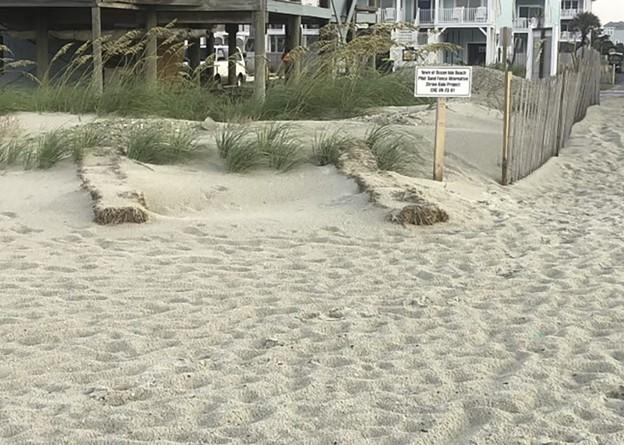
Wildlife officials push back on straw bales for sand fencing
Thorough research needs to be done on how wheat straw bales might affect oceanfront habitat before the state allows them to be used as an alternative to sand fencing, a state wildlife official said. The North Carolina State Wildlife Resources Commission has repeatedly stated its concerns in recent years about straw bales being used as a tool to protect and build up oceanfront dunes, Maria Dunn said in a recent meeting of the state Coastal Resources Commission. Dunn, who is with Wildlife Resources Commission’s Habitat Conservation Program, said that the agency understands the desire to try and maintain shorelines, but pointed out what she said are “significant differences” between traditional sand fencing and bales. “We have not objected to traditional use of sand-fencing material as long as installation was done in a manner to effectively collect wind-blown sand and not impede or block areas of the shore for public use and wildlife habitat,” Dunn said at the coastal commission’s Nov. 13 meeting. “Appropriate installation includes the location along the appropriate area of the beach profile, orientation and alignment of fencing, distance between fencing, and length of fencing down the beach profile.” The proposed rule change the coastal commission approved in April establishes specific guidelines for where and how bales may be placed on a beachfront. But the potential impacts to shoreline habitat and the animals, including endangered species and plants, that rely on that sandy habitat, remain grossly understudied, Dunn said. “It was asked if research was available on how bales impact wildlife resources on habitats on ocean shorelines,” she said. “But since they are not permitted on any other Atlantic shoreline’s state shore there is no research or data available to share with you.” The rule amendment was introduced as a way to help save permittees from waiting for sand fencing to become available during times when it is in high demand. But unlike traditional sand fencing, straw bales could potentially introduce invasive and nonnative ocean shoreline plant species to shores, influence sand temperatures and, when initially installed, take up 48 times the area that traditional sand fencing uses, Dunn said. Under the proposed rule amendment, bales cannot be placed in sections more than 10 feet long, 2 feet wide and 3 feet high and ties or binding must be removed from the bales. A permittee must repair or remove damaged, nonfunctioning, or bales sections or stakes moved from the alignment in which they were authorized. Only local governments, state and federal agencies and large, oceanfront homeowners associations would be permitted to use bales. A state Division of Coastal Management official told the Coastal Resources Commission in August that the division does not expect a significant uptick in the use of straw bales because they tend to cost more than traditional sand fencing, which would need to be replaced more frequently than fencing, and the verdict is still out on how efficiently bales trap sand. Ocean Isle Beach became the first in the state to test straw bales on a portion of its ocean shore in 2023. Ocean Isle Beach Mayor Debbie Smith told Coastal Review in late August that the bales worked well, were cheaper than sand fencing and easily accessible during a time when the town could not get sand fencing because of high demand. Dunn said that the town’s pilot program was monitored by little more than photographic documentation and some surface temperature readings. There was no designed, controlled experiment comparing different bale installments to traditional sand fencing to see which application best collected windblown said, she said. “We would recommend that such an experiment is designed with input from state and federal agencies to determine the best type of sand management tools to collect sand for dune structure while minimizing impacts to wildlife resources,” Dunn said. Smith said in a telephone interview Tuesday afternoon that she never saw a Wildlife Resources Commission representative visit the island to check sand temperatures at turtle nests or conduct other monitoring. “On any decision we have to make we can always say ‘what if,’” Smith said. “She has no evidence of some of those what-ifs. I don’t think anybody wants to do any environmental damage.” The town is working on a dune project that will begin sometime this winter. Since the proposed rule amendments have not been made formative, the town has opted to use traditional sand fencing “to move our project along and get it permitted,” Smith said. Sand temperatures play a significant role in determining the sex of sea turtles in a nest. Dunn said that a half-degree variation can change how many males or females are within a nest and possibly whether a nest remains viable. Temperatures were not taken at sea turtle nest cavity depths in Ocean Isle Beach, she said. “We don’t want to artificially create more females,” said Deb Allen, Ocean Isle Beach Sea Turtle Protection Organization coordinator. “We need a balance of males to females.” Allen pointed to studies that show when nests incubate at higher temperatures it can affect the physical and cognitive abilities of hatchlings, slowing them in their ability to make it from the shore to the ocean. “We want them to come out of that nest and we want them to crawl to that ocean as fast as possible,” she said. The coastal commission in August unanimously approved the fiscal impact analysis of the proposed rule. The fiscal analysis measures how a rule may affect a government’s revenue and expenditures to help prepare for or prevent budget shortfalls. The North Carolina Department of Environmental Quality, or DEQ, and Office of State Budget and Management also approved the fiscal analysis. A public hearing on the proposed amended rule was held Oct. 30 in Morehead City. The public comment period on the rule ends December 2. The division has not yet received comments from the U.S. Fish and Wildlife Service, according to its public information officer, Christy Simmons. The wildlife service did not respond to a request for comment in time for publication. Division officials anticipate that the amended rule will become effective April 1, 2025.
Read more » click here
Covid –

New Covid Vaccines Are Coming. Here’s What to Know.
We asked experts about the right time to get a shot, and how long protection will last.
The Food and Drug Administration approved updated Covid-19 vaccines on Thursday, paving the way for the shots to soon land in pharmacies, doctors’ offices and health centers. The Centers for Disease Control and Prevention has said it will recommend that adults and children six months and older get updated vaccines. Here’s what to know.
How are the new shots different?
The F.D.A. approved one vaccine from Pfizer and one from Moderna. Representatives from the drug companies said that their shots were ready to ship immediately after approval. Both vaccines target KP.2, a strain of the coronavirus that started to spread widely this spring. The variants that are most prevalent in the United States right now are very similar to KP.2, and so the vaccines should protect against them. “When the match is very good, as we anticipate it would be with the current circulating strains, you get actual protection from infection for several months,” said Dr. Paul Sax, the clinical director of the division of infectious diseases at Brigham and Women’s Hospital in Boston. The vaccine that rolled out last fall, by contrast, was geared at an older variant that has since petered out. The biotechnology company Novavax is waiting for the F.D.A. to authorize its retooled vaccine, which will target JN.1, a variant that is also close to the strains circulating widely now.
What if I just got a vaccine?
If you received a dose of the older vaccine this summer, you may not be able to get an updated vaccine immediately — the shots need to be spread out. People who are at high risk of developing severe disease should talk with a health care provider about the ideal interval between vaccines, said Fikadu Tafesse, a virologist at Oregon Health & Science University.
What if I just had Covid?
If you’re one of the many Americans who was infected during the summer, you may want to wait a few months to get a new shot. Rushing out to get one right after you were ill won’t give you much of an added benefit, because you already have strong protection,” said Aubree Gordon, an infectious disease epidemiologist at the University of Michigan. The C.D.C. has previously said that people can wait three months after a Covid infection to get a vaccine.
How fast does protection kick in?
It takes around a week or two after getting vaccinated for antibodies to rev up and defend against the virus. Antibodies peak about a month after vaccination, Dr. Gordon said. Once you are vaccinated, you have a lower risk of infection for at least several weeks, said Dr. Peter Chin-Hong, an infectious disease specialist at the University of California, San Francisco. “It might even be longer than that,” he said, because the vaccines are so closely matched to the dominant variants that are currently circulating. And the vaccines will provide protection against the worst outcomes from Covid — developing severe disease, getting hospitalized and dying — for months.
When should I get vaccinated?
People who are at highest risk for severe disease, including those who are 65 and older, people who are immunocompromised and those with underlying medical conditions, should get the updated vaccines as soon as they are available, Dr. Sax said. “There’s a lot circulating in the community now — that would help protect them,” he said. People who are not at high risk may want to wait until October, Dr. Chin-Hong said, both to gain protection heading into the winter and holiday gatherings, and so that they can get flu shots at the same time. “Convenience trumps everything,” he said.
Can I get it for free?
Many private insurance plans, along with Medicare and Medicaid, cover the cost of Covid shots. And children can receive free vaccines through a federal program. The C.D.C.’s Bridge Access Program, which has provided about 1.5 million free Covid shots to uninsured and underinsured people, will not be renewed for this year. But Dr. Demetre Daskalakis, director of the C.D.C.’s National Center for Immunization and Respiratory Diseases, said that the agency had found $62 million in unused vaccine contract funding that would be sent to state and local immunization programs to help cover the cost of shots.
Read more » click here
Corrections & Amplifications –
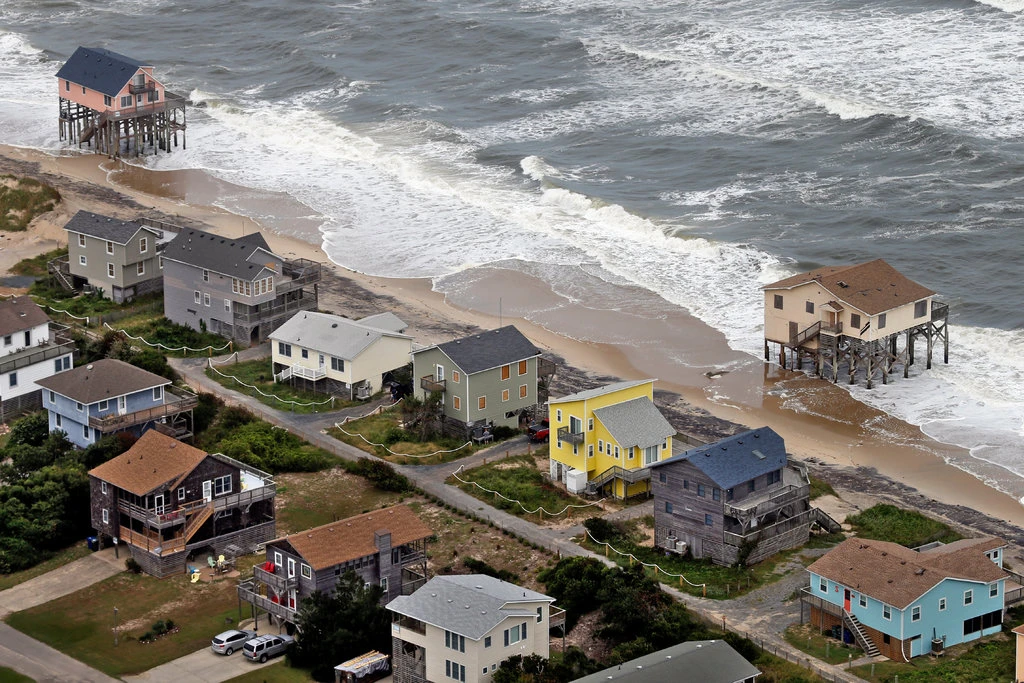
Zillow will now show climate risk data on home listings
The information is meant to help home buyers assess potential damage from extreme weather.
Potential home buyers are increasingly weighing the environmental threats their homes could face as the effects of climate change intensify across the United States. Eighty percent of buyers now consider climate risks when shopping for a home, according to a 2023 Zillow survey. To help homeowners navigate that uncertainty, Zillow is adding a climate risk threat score to every for-sale listing on its platform. Data from First Street Foundation, a nonprofit that assesses climate risk, will provide home buyers with scores that measure each property’s susceptibility to flood, wildfire, wind, heat and air quality risks. This information will be available on the Zillow app for iOS and website by the end of this year, while Android users will be able to access the data in early 2025, the company said in a release last month. Home buyers will be able to view this data on Zillow in two ways, either by looking at information within individual listings or by checking an interactive, color-coded map. The scores will display each home’s current climate risk, as well as the risk estimates for 15 and 30 years in the future — the most common terms for fixed-rate mortgages. Zillow also plans to offer tailored insurance recommendations to users alongside the risk information. First Street’s climate risk scores are established through models that measure the likelihood of a climate disaster in a given area and then the potential severity of the event, according to Matthew Eby, the company’s founder and chief executive. The company updates its models each year based on the natural disasters that have unfolded, Eby said. “This level of transparency is allowing people to choose the level of risk that they find comforting and then make an informed decision,” Eby said. “Will this change the buying experience? Absolutely.” The Zillow upgrade comes at an uncertain time for home buyers as climate change becomes more extreme. Some of the largest U.S. insurance companies have ended certain disaster protection coverage and raised premiums in response to climate risks, The Washington Post has reported. And more home listings today are affected by major climate risks compared to just five years ago, according to a report from Zillow published last month. Across all new home listings in August 2024, nearly 17 percent were at major risk of wildfire, while nearly 13 percent came with a major risk of flooding, the company said. This information could be especially valuable given that many states don’t require home sellers to disclose past flood or fire damage to potential buyers, even though more than 300,000 Americans moved to disaster-prone counties last year, The Post previously reported. A 2022 Post analysis of extreme flooding events across the country found that the Federal Emergency Management Agency’s flood maps fail to fully inform Americans of their flood risks. In a 2022 study published by real estate company Redfin, home buyers who had access to property listings that included flood risk information were less likely to view or bid on high-risk homes. That finding indicated a massive information gap for buyers regarding a home’s climate risk, according to some experts. “The information it provides is beneficial because otherwise, there’s just nothing out there for a home buyer or a renter to learn about the risk that they’re facing,” said Joel Scata, a senior environmental health attorney with the Natural Resources Defense Council. “Even if there’s debate over the methods used or the processes used, it’s better than nothing.” It’s difficult to determine the reliability of many climate risk models because the vast majority are not publicly accessible, said Benjamin Keys, a professor of real estate and finance at the University of Pennsylvania’s Wharton School who has studied the effects of climate-change-fueled disasters on insurance markets. But since the amount of climate-threat information buyers typically have has been “astonishingly low” for years, any improvement would aid transparency in the industry, he added. Climate risk modeling experts are still developing the best possible way to measure the probability of flooding, fires and other natural disasters in any given area, notes Jesse Keenan, a professor of sustainable real estate and urban planning at Tulane University. The data provided from consumer-facing models can be “uneven” depending on where a person is house-hunting, because some risks have been studied more extensively in certain regions than others, he said. “They’re not great,” Keenan said. “Some places they work well, and there’s a lot of places where the uncertainty is greater than the value.” Still, most prospective home buyers will weigh climate risks early in the hunt, and data on these risks can help flag issues they should investigate further, Keenan emphasized. For example, if a score indicates that a house is at a high risk of flooding, home buyers should talk to neighbors about their experiences or show up to the property on a rainy day. The tool should signal the start of the information-gathering process about a home’s climate risk, rather than the end, Keys added.
Read more » click here
Flood history questions added to real estate disclosure form
Sometimes it’s a puzzle why people don’t ask more questions, such as, “Has the river that’s down your road ever flooded your house, the house I’m thinking of buying?” The maxim “buyer beware” is wise advice no matter where a house is situated, but it’s good to have rules in place to cover homebuyers’ backs for the things they overlook or wrongly assume. As of July 1, prospective real estate buyers in North Carolina must now be provided the required North Carolina Real Estate Commission residential disclosure form by the seller that for the first time includes questions related to a property’s flood risk. The change in the form was requested in a petition for rulemaking filed by the Southern Environmental Law Center in December 2022 on behalf of the Natural Resources Defense Council, or NRDC, the North Carolina Justice Center, MDC Inc., the North Carolina Disaster Recovery and Resiliency School, Robeson County Church and Community Center, and NC Field. “Most of those are small, local nonprofits that respond to disasters,” Brooks Rainey Pearson, senior attorney with the law center, told Coastal Review in an interview, referring to petitioners. “So, we really wanted to give a voice to the people on the ground who deal with the fallout from flooding.” Pearson said that the Real Estate Commission had quickly granted the petition at the time and agreed to add the questions proposed by petitioners. It was then delayed by mutual agreement, she said, to adjust the law to allow the commission to merely make changes in the form. That would avoid having to go through a lengthy rulemaking process. “It was a longer journey than it should have been, but not because of any pushback,” she said. “I think everyone understands that homebuyers deserve to know if the property has flooded before.” Questions about flooding that have been added to the disclosure statement include the following: Is the property located in a federal or other designated flood hazard zone? Has the property experienced damage due to flooding, water seepage or pooled water attributable to a natural event such as heavy rainfall, coastal storm surge, tidal inundation, or river overflow? Is there a current flood insurance policy covering the property? Is there a flood or Federal Emergency Management Agency elevation certificate for the property? Has (the property owner) ever filed a claim for flood damage to the property with any insurance provider, including the National Flood Insurance Program? The form also notes that the requirement to obtain flood insurance passes down to all future owners for those properties that have received disaster assistance. Joel Scata, senior attorney with the NRDC, a national environmental nonprofit organization that is one of the petitioners, said that in the past, the only flood information that had to be disclosed to homebuyers in North Carolina was whether the property was in a floodplain. “Now with the changes, a buyer is going to have access to much more detailed information,” he told Coastal Review. According to state law, residential property owners are required to complete the disclosure statement and provide it to a buyer before an offer is made to purchase the property. New construction or never-occupied properties are exempted. Every question must be answered with “Y,” “N,” “NR” or “NA” for “Yes,” “No,” “No Representation,” and “Not Applicable,” respectively. Despite stern language in the form about requirements, there is enough gray area to give pause to anyone with insight into human failings. “An owner is not required to disclose any of the material facts that have a NR option, even if they have knowledge of them,” the statement says. Also: “If an owner selects NR, it could mean that the owner (1) has knowledge of an issue and chooses not to disclose it; or (2) simply does not know.” The form does warn that failure to disclose hidden defects “may” result in civil liability. It also assures that if an owner selects “No,” it means that the owner is not aware of any problem. But if “the owner knows there is a problem or that the owner’s answer is not correct, the owner may be liable for making an intentional misstatement.” If an owner selects NA, it means the property does not contain that particular item or feature. Scata said that he believes that whatever remedies are available for enforcement are strictly civil, and do not include criminal charges in the case of fraud or misrepresentation. “A buyer could file a civil suit, claim that the seller intentionally misled the buyer, make a fraud claim,” he said. But damages and other penalties would depend on the impact of what wasn’t disclosed, he added. A buyer should take any “NR” answer as a cue to ask the owner about what they don’t want to disclose, Scata said, adding “it’s a good indication that something is wrong with the property.” That choice could not be removed from the form unless it was done through a change in the legislation, he said. “The buyer always has the right to go back and explicitly ask the seller the question,” he said. And don’t just push the question with the buyer, he said, but also go talk to neighbors about the situation with flooding episodes in the neighborhood. Also, real estate brokers by law have a duty to disclose what they know, or reasonably should know, regardless of the seller’s response. “So, if a seller says something like ‘No, there’s never been (flooding) on the property,’” Scata said, “but the Realtor knows that’s not true, there’s a duty on them to disclose. And they can be liable if they are complicit in that fraud.” In that instance of potential fraud by a broker, the buyer can file a complaint with the Real Estate Commission. According to an NRDC press release, homes in North Carolina with prior flood losses would be expected to average an annual loss of $1,211, compared to $61 for the average home. In 2021, there were 13,237 homes purchased that were estimated to have been previously flooded. The expected annual flood damage totals for those homes were estimated at about $16 million. With climate change causing more intense rain and stronger storms, flooding is only going to become more of an issue, Pearson said. “Before when you only had to disclose if the house was in a floodplain, well, that’s no longer a good indicator of whether your house might flood,” she said. “The best indicator of whether your house might flood is whether it’s flooded before. And so, we think, just for the sake of transparency, people deserve to know that. But they also deserve to know that because — I believe it’s called behavioral economics — when people have more information, they’ll make different and better decisions.”
Read more » click here
Odds & Ends –
Brunswick County to explore creating a stormwater utility
Brunswick County commissioners will not pause new development. Instead, board members agreed during their Monday night meeting to further explore the possibility of creating a stormwater utility as a way to address mounting concerns about the county’s ongoing building boom. “The stormwater utility would help solve the problem of increased growth, polluted stormwater, and improve the drainage capabilities of the county that are susceptible to flooding,” Commissioner Pat Sykes said. “Within this we should be able to designate certain areas as special protection areas. These areas would determine, should they be low, medium or high density.” This utility is created to collect fees from property owners, which are then used to maintain and improve drainage systems. Sykes eventually seconded a motion made by Chairman Randy Thompson to direct county staff to move forward with coming up with a plan to establish a temporary moratorium on new commercial, multifamily and single-family home construction. Thompson suggested a moratorium would span 120 days. Commissioners voted down the motion 3-2. “I’m sorry, but I’m not in favor of a moratorium,” Commissioner Marty Cooke said. “I don’t see legally we can do it.” Thompson reiterated concerns he raised at the board’s Sept. 23 meeting as reasons for implementing a building pause, one he and supporters of a moratorium say is needed to give the county time to examine its water and wastewater service capacity, current fire service adequacy, impacts of pending construction, floodwater management, and update its unified development ordinance, or UDO. “I honestly believe that all these things need to be addressed,” he said Monday night. “They need to be addressed quickly, but it takes time to address them properly and so that is why I am still firmly in the belief that we need to do a moratorium.” Others agreed, arguing that the county can make the case a building moratorium is needed to address imminent public health and safety concerns. Gene Vasile, president of the Alliance of Brunswick County Property Owners Association, said Thompson’s comments at the Sept. 23 meeting summarized the most serious consequences of “excessive development.” “Ask yourself, how can developments the size of small towns be approved in areas that are served by volunteer fire departments?” Vasile said. “The consequences of rapid development without advanced planning for its ramifications are serious and irresponsible. In the interest of public health, safety and good order, a moratorium on the approval of certain new development is essential.” Shallotte Mayor Walter Eccard shared those sentiments, saying he believed county commissioners have the authority to declare a moratorium “for the purpose of addressing public safety and adequacy of infrastructure.” Eccard, who said he was speaking as a resident of the county, referenced widespread damage in the county caused by flooding from the unnamed storm that dumped more than 15 inches of rain onto the area last month. “The impact of recent uncontrolled growth and its related clear-cutting raised, at a minimum, serious questions with respect to the adequacy of the county’s rules for stormwater control, flood mitigation and other matters,” he said. “As you know the recent storm resulted in local flooding, road closures, bridges destroyed, limitations of emergency vehicle access and inadequate evacuation routes. These present serious public health and safety concerns.” Major new developments, Eccard said, have been approved without a review of whether existing fire and emergency services could adequately serve them. “It’s clear to many of us that this is a recipe leading to catastrophe,” he said. Rather than call for a building moratorium, St. James Mayor Jean Toner asked commissioners immediately approve text amendments to the county’s UDO that address trees and green space, transportation overlay zoning and transportation impact analysis. Toner said rampant clear-cutting, high-density housing and inadequate requirements for developers to create open space, “have created a situation where development is neither well-managed nor responsible.” “Since 2020 the county has approved 37,500 new housing units,” she said. “UDO text amendments are necessary to mitigate the problems that result from these changes. Revisions to mitigate flooding associated with stormwater runoff are overdue. How much more flooding, damaging homes, businesses and roads and bridges, must we experience before change is made?” Rather than establish a building moratorium, County Manager Steve Stone recommended to commissioners amend the county’s stormwater ordinance and enhance the flood prevention ordinance. Specifically, Stone suggests developers be required to include stormwater designs for a 100-year storm event rainfall. Currently, the ordinance requires plans for a 25-year event. “It’s technically feasible to implement this change within 120 days of beginning the process,” he said, referring to a stormwater ordinance amendment.
Read more » click here
 Republicans in North Carolina pass sweeping changes to consolidate power
Republicans in North Carolina pass sweeping changes to consolidate power
The last-minute inclusions in a lame-duck bill will strip the incoming Democratic governor and attorney general of significant authority before the GOP loses its legislative supermajority.
Republicans in North Carolina rushed a bill through the legislature this week to boost their power before they lose their supermajority, approving a measure to give their party more control over elections, eliminate the jobs of judges who have ruled against them and limit the authority of the incoming Democratic governor and attorney general. Republicans hold three-fifths majorities in the legislature and have used that power to override vetoes by Gov. Roy Cooper (D). In January, they’ll lose the ability to easily roll back vetoes by incoming Gov. Josh Stein (D) because they’ll no longer hold such a large majority in the North Carolina House. The GOP response has been to flex their power now, while they still have it. They loaded up a $227 million Hurricane Helene relief package with an array of provisions that weaken the hand of Stein and other Democrats in the battleground state. Hours after unveiling the proposals, the state House passed the bill Tuesday night, and the state Senate approved it Wednesday. The lame-duck bill will shift the ability to appoint members of the state and county elections boards from the governor to the state auditor. That will mean Republicans instead of Democrats will control those boards, which oversee ballot tallies, set voting rules and decide how many early-voting locations to open. “It’s really one of the more blatant partisan power grabs for authority over elections that we’ve seen in recent years,” said Megan Bellamy, vice president for law and policy for the nonprofit Voting Rights Lab. “And the fact that it’s packaged into a bill that’s meant to provide much-needed hurricane relief and support there is beyond the pale.” State Rep. Destin Hall, whom Republicans have chosen to serve as speaker starting in January, downplayed the sweep of the changes in an exchange with reporters after the measure passed his chamber. “I don’t know that there were any real shockers in there, and they’re things that we’ve talked about and debated before the storm,” he said. The bill tightens the time frame — from nine days to three — for voters who don’t have a photo ID with them at the polls to ensure their votes count. Voters who don’t have their ID with them or have other issues that prevent them from casting ordinary ballots can cast provisional ballots that are counted if they later clear up any problems. Under the bill, they will need to act much faster in future elections. Provisional ballots have proved crucial in this month’s race for state Supreme Court, where the Democratic incumbent leads a Republican challenger by several hundred votes. Another provision would require officials to review and tally absentee ballots that arrive on Election Day that night. That would add many hours of responsibilities to already overworked election officials, said Gerry Cohen, a Democrat on the Wake County Board of Elections. “I think it would result in election directors resigning,” he said. “Who would want to administer a process if there’s some legal liability where it’s impossible to actually carry out the law? Impossible.” Under another section of the bill, the governor must fill any vacancies on the state’s top courts with appointees recommended by the political party of the departing judge. That will prevent Stein from appointing Democrats to fill future openings on the state Supreme Court, where Republicans hold a majority. In addition, the bill will eliminate the jobs of two judges who have ruled against lawmakers. Democrats called the bill’s Hurricane Helene relief efforts hollow because it sets aside $227 million but does not allocate how it will be spent. Cooper said the legislation “prioritizes more power grabs” over hurricane relief, and Stein said Republicans were “exacting political retribution.” Three House Republicans from hurricane-ravaged western North Carolina voted against the bill, boosting the hopes of Democrats that they might side with Cooper if he vetoes the bill as expected. But Hall, the incoming speaker, contended that the three Republicans would join the majority in an override vote, according to the News & Observer. Republicans’ last-minute move to hamper the power of Democrats echo their efforts in 2016 to limit the authority of Cooper in the weeks between his election as governor and his inauguration. Two years later, Republicans in Wisconsin’s legislature took the same step before Democrats were sworn in as governor and attorney general. The latest North Carolina bill will also give lawmakers the authority to block the governor’s choice to lead the state highway patrol. And it will curb the power of incoming Attorney General Jeff Jackson (D) by barring him from arguing in court to invalidate state laws — such as the lame-duck measure itself. The measure seeks to hobble Stein and Jackson just two weeks after they won their elections. Stein won his race by nearly 15 percentage points, and Jackson won his by nearly three percentage points. Democrats called it ridiculous to put the state auditor — an official who reviews state finances — in charge of appointing election officials. This month, attorney Dave Boliek was elected auditor, making him the first Republican to hold the job in 16 years. Republicans in North Carolina have failed in repeated efforts over the past eight years to take control of the state elections board. Their attempt started with a provision in the lame-duck legislation that stripped power from Cooper just before he took office. A court blocked the change to the state elections board included in that legislation, and the North Carolina Supreme Court later struck down a modified version of the GOP plan. In 2018, GOP lawmakers asked voters to amend the state constitution to reshape the elections board. Voters rejected the idea. Most recently, Republican lawmakers passed a measure in 2023 to change the makeup of the board. That bill, too, was blocked by the courts. An appeal is ongoing.
Read more » click here
North Carolina Republicans Push to Seize Power From Top Democrats
The state’s Republican-controlled legislature passed a sweeping bill that would erode the power of the Democratic governor and attorney general and hand the G.O.P. more control over elections.
The Republican-controlled legislature in North Carolina passed a bill on Wednesday that would strip key powers from the incoming Democratic governor and attorney general in addition to giving the G.O.P. more control over elections and judicial appointments. The changes, included in a 131-page bill that was designed to deliver much-needed disaster relief for areas of the state devastated by Hurricane Helene, come as Republicans are likely to lose their supermajority in the legislature after defeats in this month’s elections. Josh Stein, a Democrat, will be the next governor, succeeding Roy Cooper, another Democrat. The bill would significantly restructure the state election board, the top authority over voting in North Carolina, wresting appointment power away from the governor’s office and handing it to the state auditor, who will be a Republican next year. The change would be likely to put the board, which currently has three Democrats and two Republicans, under G.O.P. control. The legislation would also significantly restrict the governor’s ability to fill vacancies on state courts, including the Supreme Court, by limiting the options to candidates offered by the political party of the judge leaving the seat. And it would curtail the ability of the attorney general — currently Mr. Stein, and next year Jeff Jackson, another Democrat — to challenge laws passed by the legislature. Beyond those proposals, the bill would make major changes to state election procedures. It would significantly shorten the time voters have after Election Day to address problems with their mail and absentee ballots — a process known as curing — and would require local election officials to finish counting provisional ballots within three days of the election. The State Senate’s passage of the bill on Wednesday sends it to Mr. Cooper, who has 10 days to sign or veto the legislation before it becomes law automatically. North Carolina does not allow its governors to veto parts of a bill, so he would have to reject the entire measure, including the hurricane relief provisions. Adding to the drama, Mr. Cooper was in Washington on Wednesday, seeking more federal hurricane relief — which under North Carolina law meant that Lt. Gov. Mark Robinson, the controversy-prone Republican who lost the governor’s race to Mr. Stein, was serving as the acting governor. But Mr. Cooper’s office said it did not expect the bill to reach the lieutenant governor on Wednesday. The Republican supermajority in the legislature means that the party could override a veto by Mr. Cooper if its lawmakers all vote together. But they could face some intraparty headwinds: On Tuesday night, three House Republicans from the western counties hit hardest by the hurricane voted against the bill, only 13 pages of which ultimately included storm relief measures. One of those Republicans, State Representative Mike Clampitt, said in a brief interview on Wednesday that he had been deeply disappointed and surprised by the bill, particularly because it did not provide sufficient money for disaster aid. “There was stuff that should be in next year’s budget that was in there,” he said. “That shouldn’t have been in there.” Asked if he would vote to override a potential veto from Mr. Cooper, Mr. Clampitt said: “I’ll have to cross that bridge when I get to it. We’re not there yet.” The gallery in the State Senate was packed on Wednesday as the chamber debated the bill. Onlookers hissed and flashed a thumbs-down as State Senator Ralph Hise, a Republican, discussed the bill’s details, and cheered Democratic lawmakers who stood in opposition. Mr. Robinson, agitated at the applause for the Democrats, ordered the gallery to be cleared less than 20 minutes into the debate, saying they were “immature people.” “You are overturning the will of the people!” one person yelled. “You’re a fascist,” another screamed as the crowd exited the building to chants of “Shame! Shame!” Mr. Hise, rising in defense of the bill, ignored the criticisms of provisions that would erode the authority of the governor and others, and instead defended the bill as a necessary first step in recovery from the hurricane. “This is not a quick recovery for western North Carolina; this will be a yearslong process,” he said, adding that he still could not drink the water in his home. He criticized those making “a whole bunch of crazy claims that were not doing anything for the people of western North Carolina.” Earlier in the debate, Mr. Hise said the reason for shortening the timeline for counting provisional ballots was to achieve a “timelier resolution of election outcomes.” Provisional ballots have tended to favor Democrats in recent elections, including in North Carolina’s State Supreme Court race this year. The Democratic incumbent, Allison Riggs, led the race by about 600 votes after provisional ballots and outstanding absentee ballots were counted; it is now heading to a recount. The first state senator to rise in opposition to the bill was Julie Mayfield, a Democrat who represents western North Carolina. “This bill does not meet the spirit of the moment, and I will not be able to vote for it,” she said. “It would have been easy to break out the Helene relief portions from this bill from the rest of a bill that takes purely partisan aim at some of the foundational pillars of our democracy,” she said. Phil Berger, the top Republican in the State Senate, told reporters after the vote on Wednesday that Republicans’ passage of the jumbo bill was “all within the rules,” adding that they sought to restructure the election board to “have balance.” Asked if they had chosen to give appointment power to the auditor’s office because a Republican would hold it next year, Mr. Berger said, “No, it’s because we felt that the auditor’s office was a place that would work.” Republicans have had a stranglehold on the North Carolina legislature since 2011, and they have pursued similar power grabs in recent years. After Mr. Cooper was elected in 2016, the legislature sought to limit the number of state employees the governor could hire, shift some of his responsibilities to the lieutenant governor and require Senate confirmation for cabinet positions. Republicans in Wisconsin and Michigan borrowed from that playbook in 2018, when they sought to strip powers from incoming Democratic governors. In Wisconsin, parts of the push were successful, but Michigan’s departing Republican governor vetoed the effort there. During the 2021 redistricting process, the North Carolina legislature drew a congressional map with 11 of the state’s 14 House seats favoring Republicans — a striking advantage in a state that is almost evenly divided politically. Despite its long history of partisan fights, North Carolina had recently come together in response to Hurricane Helene, which ravaged western areas of the state. Asheville, a fast-growing city tucked in the Blue Ridge Mountains, was hit by unrelenting flooding, which left tens of thousands of residents without drinkable water or power for weeks. Mr. Stein, the incoming governor, criticized the legislature for tethering hurricane relief to the measures targeting Democratic power. “Many people and communities are hurting and need our help,” Mr. Stein wrote on social media on Tuesday. “But instead of stepping up, the Republicans in the General Assembly are grabbing power and exacting political retribution.” Mr. Jackson, the next attorney general, said in an interview on Wednesday that the bill “should be focused on Helene response to help people — it really shouldn’t be used to sneak through major policy changes,” including some that would “undermine the independence of the attorney general.” Karen Brinson Bell, the executive director of the State Board of Elections, said in a statement that the board had not been consulted about the legislation. She added that the bill “may make it impossible for the county boards of elections to adequately ensure every eligible ballot cast is counted, especially in high turnout elections.” This is not the first time Republicans have tried to give their party control of the state election board. Last year, G.O.P. lawmakers passed a bill to allow the legislature to make appointments to the board. Mr. Cooper challenged the law, arguing that it was an unconstitutional violation of the separation of powers. A three-judge state panel agreed with him, and the effort was in legal purgatory during the 2024 general election. By shifting authority over the election board to the state auditor, the legislature appears to be working around the legal concerns about separation of powers, because the auditor is part of the executive branch. The effort to tighten election laws in North Carolina also follows a yearslong push by Republicans in battleground states to exert more influence over how elections are run. After the 2020 election and ahead of the 2022 midterms, right-wing activists backed by the election-denial movement organized a coalition of candidates to run for secretary of state, the top role overseeing elections in most battleground states other than North Carolina and Wisconsin. But those candidates were defeated in every competitive state in 2022. Dave Boliek, the incoming Republican auditor, ran a campaign promising to rein in spending, especially at the state’s division of motor vehicles. He often pledged to “audit” the board of elections but offered little detail. In August, he earned the endorsement of Donald J. Trump, who called out Mr. Boliek by name during a speech about the economy, recalling that the candidate for auditor had told him, “I’m only in politics for you, sir.” “Where is Dave?” Mr. Trump said from the stage, scanning the audience. Spotting Mr. Boliek, he asked, “Do you mean that?” Mr. Boliek shouted back, “I mean it!” “If you mean that, I’m for you all the way,” Mr. Trump replied. “He has my endorsement. Thank you, Dave.”
Read more » click here
This and That –
 What’s behind the name of this seaside town in Brunswick County?
What’s behind the name of this seaside town in Brunswick County?
How did a seaside community in Brunswick County, located midway between Wilmington and Myrtle Beach, South Carolina, get its name? The island of Holden Beach is named after Benjamin Holden, who bought four mainland tracts and the island between his plantation and the ocean in 1756. The island extended from Lockwood’s Folly Inlet west six miles to Bacon Inlet. Holden and his sons used the island for fishing and cattle grazing. John Holden, Benjamin’s grandson in 1924, began a commercial fishery on the island. Holden also started planning a vacation destination, which is called the Holden Beach Resort. It was the first subdivision of oceanfront property in Brunswick County. The town of Holden Beach was incorporated on Feb. 14, 1969. A new high-rise concrete bridge was dedicated on May 13, 1986, allowing better access to the more than 1,900 homes on the island. The Holden Beach Fishing Pier has been closed to the public since 2022, but steps are being taken to either reopen or revamp the structure.
Read more » click here
 Fear the deer: Crash data illuminates America’s deadliest animal
Fear the deer: Crash data illuminates America’s deadliest animal
Behold the deer, the deadliest beast in North America. Deer are responsible for the deaths of about 440 of the estimated 458 Americans killed in physical confrontations with wildlife in an average year, according to Utah State University biologist Mike Conover, employing some educated guesswork in the latest edition of “Human-Wildlife Interactions.” Those deer-inflicted fatalities are not, so far as we know, caused by deer-on-human predation. They’re the unfortunate result of more than 2 million people a year plowing into deer with their sedans and SUVs, usually on a two-lane road, often at high speed. You might wonder: Where and when am I most likely to hit a deer? And how can I avoid it? To shed light on this herbivorous hazard, we turned, of course, to data. Specifically, we analyzed more than 1 million animal-vehicle collisions compiled by Calumn Cunningham, Laura Prugh and their colleagues at the University of Washington for a recent paper published in Current Biology. They estimate deer were involved in more than 90 percent of the collisions, which occurred in 23 states between 1994 and 2021. With a few exceptions, the data show deer are at their most dangerous in November. Indeed, the deer threat peaks just before Thanksgiving — typically Nov. 7 through 14 — when you’re about three times more likely to hit a deer than at any other time of year. Experienced deer hunters can probably guess why driving in November can turn into Russian roulette on certain highways and byways: In much of the country, that’s rutting season. And during the rut, deer focus on procreation, not self-preservation. Marianne Gauldin of the Alabama Wildlife and Freshwater Fisheries Division compares rutting bucks to teenage boys. “They are hyper-focused on the opportunity to breed, and they therefore lose some of their wits,” Gauldin said. “They are full tilt looking for does, chasing does and running after does for the opportunity to breed. And they are doing this with tunnel vision … literally running across the road.” Does share similar distractions. They’re either in estrus — hormonally receptive to sex and looking to breed — or fleeing hot-and-bothered bucks until their cycles catch up. Collisions occur more often in states with the most white-tailed deer — which experts say tend to have a shorter, sharper rut than the western mule deer — and in states with long stretches of busy rural roads. Separate insurance claim data from State Farm, which is widely cited in academic research, shows a driver out minding her own business on the wending, bending roads of West Virginia had a 1 in 35 chance of hitting an animal between June 2021 and June 2022, making the Mountain State easily the most dangerous in terms of deer-car collisions. Montana and Michigan were next. D.C. drivers, by contrast, had only a 1 in 907 chance of stopping a buck while driving down Pennsylvania Avenue, or anywhere else. Fun fact: Deer are responsible for at least 69 percent of animal-related accident claims, according to State Farm. Another 12 percent of claims involve unidentified animals, many of which could be deer that bounded off before the driver got a good look at them or were mangled beyond recognition in the crash. The third-most-dangerous animals on the road are undifferentiated rodents, which are cited in 5 percent of all animal-related accident claims. However, State Farm spokesperson Dave Phillips noted that many of the drivers never make contact with said rodent: The vast majority of those accidents occur when motorists swerve to avoid a suicidal squirrel or moseying marmot. Our more calendar-conscious readers will note that peak deer-crash season coincides with another big moment in November: the first week of daylight saving time, which begins the first Sunday of the month. And the University of Washington team has found that the two events are not unrelated. To understand why, we need to spelunk deeper into their data, which breaks new ground by including the exact location, date and hour of all these deer disasters. When we glance at a chart of accidents that includes time of day and time of year, one fact strikes us right between the headlights: Evening, the twilight of each day — especially in November! — is the hour of the Götterdeermmerung. Conveniently for us, the University of Washington scholars used accident coordinates and some basic weather math to calculate exactly when the sun would have risen or set at each location. It turns out that deer danger skyrockets about 30 minutes after sunset and remains extraordinarily elevated for almost half an hour. Those with deer-behavior expertise say drivers should be on high alert as darkness falls in autumn — especially when careening through the deer’s favorite transitional habitats, the forest-edge ecosystem created by roads and other developments. But they urge us to take a lesson from the thousands of people who land in hospitals and body shops each year after attempting to avoid a turtle or chipmunk: If you do see a deer, don’t swerve. “Slow down as much as you can, obviously, coming up to it,” said Karlin Gill of the National Deer Association, a hunting and conservation organization. “But if it’s unavoidable and you’re going to hit the deer, don’t try and swerve out of the way. That can cause an even worse car wreck, and you still might hit the deer regardless.” Deer crashes also rise in the morning, about 30 minutes before sunrise, but the number is significantly lower than after sunset. To understand why, we need to dig deeper into both deer and human activity patterns. Biologist after biologist told us deer are crepuscular, meaning they’re most active at dawn and dusk. When Texas A&M University wildlife scientist Stephen Webb and his colleagues fitted GPS trackers onto white-tailed deer in Oklahoma, they found deer movement peaks at both sunrise and sunset. “Deer, unlike humans, don’t lay down for eight hours at night and then get up and move throughout the day,” said Gill , who, as a hunter, closely examines deer behavior. “They actually go through a cycle where they’ll lay down, bed, get up, eat, lay down, bed, get up, eat, and they’ll do this throughout a 24-hour period.” But if deer are equally active at dawn and dusk, why are they so much more likely to be hit in the evening? To untangle that one, we need to examine another somewhat crepuscular species: the American commuter. Our commutes also peak in the morning and evening, but we’re much more likely to be driving at dusk than we are at dawn, and we stay on the roads even as darkness falls, and the deer start moving — often squarely into our headlights. It’s a matter of visibility. Deer are just as active two hours before dusk as they are two hours after, yet we’re about 14 times more likely to hit a deer after sundown than we are before. And, as Cunningham notes, right at the peak of the whitetail rut, we throw another variable into the stew: We end daylight saving time. Suddenly, as far as the deer are concerned, our 6 p.m. commute happens an hour later. Millions of drivers find themselves contending with lower visibility just as sex hormones flood the local deer population. “It’s like one of the grandest-scale natural experiments that we can come up with, where humans impose these very arbitrary and abrupt changes on the wildlife,” Cunningham told us from his native Tasmania (he’s at the University of Washington as a Fulbright fellow). People living on the far eastern side of a time zone are about 1.35 times as likely to hit a deer as folks on the far western edge, since folks in the east are more likely to be driving home in the dark. Similarly, folks in Northern states, where days are short and darkness rules the winter, are 1.86 times more likely to hit a deer than their friends in America’s sunny South. Taking these effects into account, the University of Washington team estimates that “falling back” causes a 16 percent jump in deer carnage in the weeks after the shift. It’s possible that adopting permanent daylight saving time would thus save the lives of more than 36,000 deer and 33 humans each year. On the down side, chronobiologist Eva Winnebeck of the University of Surrey argues that any gains might be offset by an increase in deaths spurred by the chronic drowsiness that would inevitably set in if our solar-powered circadian rhythms were forced to endure a never-ending disconnect between the sun and clocks set permanently to daylight saving time. Here at the Department of Data, we’ve found a strong connection between happiness and the great outdoors. So, we’re partial to any move that would give us more daylight hours to get out after work and fish, run or dominate the competitive wood-chopping circuit, circadian rhythms be darned.
Read more » click here
Watch out for deer
NCDOT warns motorists across North Carolina to stay alert for deer now that fall has arrived. Every year during late autumn, auto and body shops across the region brace for a bumper crop of business, comprised of an influx of cars with damage from collisions with deer. Beginning in October, roads across the state become hazardous as North Carolina’s deer population fans out, lurking on highway shoulders in search of food and potential mates. It’s the deadliest time of the year for deer, which also pose a particular danger to motorists. Nearly half of vehicle accidents involving white-tail deer occur from October to December. Deer accidents typically begin rising in October, peak in November and begin dropping off after December, according to the Insurance Institute for Highway Safety. Deer are crepuscular mammals, meaning they’re most active at dawn and dusk – which, following the onset of daylight savings time, places them near roads and byways precisely when large numbers of residents are commuting to and from work.
NCDOT has some helpful tips for motorists in regard to deer-vehicle crashes:
- Although it does not decrease the risk of being in a crash, wearing a seat belt gives you a better chance of avoiding or minimizing injuries if you hit a deer or other animal.
- Always maintain a safe amount of distance between your vehicle and others, especially at night. If the vehicle ahead of you hits a deer, you could also become involved in a crash.
- Slowdown in areas posted with deer crossing signs and in heavily wooded areas, especially during the late afternoon and evening.
- Most deer-vehicle crashes occur where deer are more likely to travel, near bridges or overpasses, railroad tracks, streams, and ditches. Be vigilant when passing through potentially risky landscapes.
- Drive with high beams on when possible and watch for eyes reflecting in the headlights.
- Deer often travel in groups, so if you see one deer near a road, be alert that others may be around.
- If you see deer near a road, slow down and blow your horn with one long blast.
- Do not swerve to avoid a collision with deer. This could cause you to lose control of your vehicle, increasing the risk of it flipping over, veering into oncoming traffic, or overcorrecting and running off the road and causing a more serious crash.
Officials say the most crashes occur between 6 p.m. and midnight, accounting for about 45% of the overall total. With the end of daylight savings time at 2 a.m. Sunday, Nov. 1, the time shift increases the chance of deer being by roadways when drivers are traveling in the dark, especially for their evening commute. If your vehicle does strike a deer, officials say do not touch the animal. A frightened and wounded deer can be dangerous or further injure itself. Get your vehicle off the road if possible and call 911.
Read more » click here
Factoid That May Interest Only Me –
 Gators’ more frequent appearances make splash along coast
Gators’ more frequent appearances make splash along coast
Did you hear the one about the alligator? An alligator walks into … a road, a pool, a miniature golf course, onto a beach, underneath a car, up to the front door of a storefront, by a back entrance of a police station. Stop me if you read about this while perusing the headlines of your local newspaper, heard about it on the 6 o’clock news, or saw it plastered across social media platforms this past summer. Alligators have made quite the splash (pun intended) in recent months here in southeastern North Carolina, where seemingly numerous public appearances by these living dinosaurs have produced dramatic headlines and videos shared not only across the state, but the country. But these typically reclusive reptiles aren’t looking for all the attention they’ve been getting, experts say. They just want to be left alone. The problem is, they’re being squeezed out of seclusion as housing developments and retail centers continue to crop up along the coast. “The ever-growing population along the coast of North Carolina is the biggest threat to wildlife in general,” said John Harrelson, a wildlife biologist with the North Carolina Wildlife Resources Commission. “Habitat loss is the biggest threat to wildlife in general, not just alligators, and when people move in and we build communities in places that haven’t historically had people, then that leads to lots of interactions.” And the more interactions that occur, the more comfortable alligators become around people. Harrelson puts alligators into one of two categories: country alligators and city alligators. Country alligators inhabit areas up the Northeast Cape Fear River. He said that those alligators generally try their best to steer clear of humans, he said. But city alligators get used to seeing people and, just like squirrels, birds, deer, and other animals, they become habituated, “realizing that people, for the most part, don’t mean them any harm and that there’s nothing to be worried about,” Harrelson said. Think of it like a cost-benefit analysis where an alligator weighs the risk of being around people and decides whether the reward is worth the risk. “And often times the reward is great enough,” Harrelson said. While development strips away their natural habitat, it tends to provide pockets of prime real estate for alligators in the form of retention ponds. Harrelson works in the commission’s District 4, which includes Brunswick County, and is home to a reported 30 scenic golf courses (think about all of the water hazards — well, not a hazard from a gator’s point of view — on just one of those courses). Brunswick, Columbus, Craven, New Hanover, Onslow, and Pender counties are home to the largest populations of American alligators in North Carolina and their turf runs from the state’s coastal plains to Texas. With its barrier island beaches, proximity to Wilmington and Myrtle Beach, South Carolina, and its numerous golf courses, Brunswick County has become a draw for retirees who, for many, move in from areas where there are no alligators. Pair that with the influx of tourists who flock to the county each summer – Oak Island’s population more than quintuples between May and August – and odds are high people are going to encounter alligators. Boiling Spring Lakes Police Capt. Windy Hager knows that when tourism season picks up, so too do the number of calls going into the Brunswick County town’s law enforcement center about alligator sightings. “When it’s warmer (alligators) become more active and, when you’ve got people who are not familiar with alligators they get a little excited about, ‘Oh, there’s one in the lake!’ Well, yes, that’s where they live and that’s what we have to tell them a lot of times,” Hager said. Hager has lived in the area more than 10 years. She’s accustomed to seeing alligators pretty regularly in their own habitat. But one had to be removed from a swimming pool a couple of weeks ago and the unnamed storm that pummeled Brunswick County with catastrophic rainfall Sept. 16 means there’s a lot of water in places that were previously dry. “I know that there’s two (alligators) in what used to be somebody’s front yard right now in the city because their front yard is flooded,” Hager said. “But they’re just doing their thing and the people who live there are giving them their space. The people are not messing with them and the alligators aren’t messing with the people so they’re sharing space right now.” Two days before he spoke in a telephone interview with Coastal Review, Sunset Beach Police Animal Control Officer Bill Arp had removed a small alligator hanging out underneath a car. “They’ll wind up in people’s garages and on people’s porches, underneath decks, under cars. We find them all over the place,” he said. “Unfortunately, because of such huge development down here, their habitat is starting to shrink and that’s what’s happening. People are calling us and wondering, ‘Why’s it under my car? Why are they on my porch? Why are they in my garage?’ Well, that’s why because the development is robbing them of their other habitat.” Alligator Do’s and Don’ts If an alligator settles in an area near you, wildlife and law enforcement officials have tips on how to safely cohabitate. “A lot of people think, even with birds and deer, it’s nice to feed them,” Arp said. “But alligators, you don’t. Everybody knows an alligator is an apex predator. They’re nice to watch. They’re nice to take pictures of, but to feed them, that’s not a good idea.” Remember what Harrelson said earlier in the story about city alligators? “Individual people feeding alligators is the worst thing you can do,” he said. “Alligators are wild animals and they’ve got to work for their food. An easy meal means, ‘hey I don’t have to continue to fail and fail and make all these attempts when I’m not successful. I can just wait for this person to walk over and, if I approach them, they’re going to give me chicken or bread or marshmallows, a fish scrap or whatever else they’ve got.’ We deal with this all the time, particularly with folks who aren’t locals.” It is illegal to feed alligators. It is also illegal to kill them. American alligators are protected by the Endangered Species Act as threatened. In North Carolina, a permit is required to hunt alligators. The monthlong season is limited to population control at the request of municipalities in Brunswick, Carteret, Columbus, Craven, Hyde, Jones, New Hanover, Onslow, Pamlico, and Pender counties, according to the WRC website. “The Commission does not plan to issue permits to take American alligators, outside of municipality requested population reduction hunts, until further research is conducted to determine the conditions under which alligator populations would be sustained while allowing limited harvest,” the site states. Harrelson said that alligators are relocated only as a last resort because they, like other wildlife, have a propensity to travel long distances to return to where they were captured. “This is something that we face ongoing and, as biologists, something that we have to figure out how to address going forward because our agency isn’t going to pick up and move animals,” Harrelson said. “We want to let wildlife be wildlife for as long as we can and maintain the ecosystems that are out there.” As people build, alligators move. Males can occupy areas greater than 2 miles so, when they move, they’re crossing roads, ditches, and yards. An alligator may be removed from a property when it is considered a nuisance – at least 4 feet long and poses a threat to people, pets, or property. To report a potential nuisance alligator, call the N.C. Wildlife Helpline at 866-318-2401. Experts say simply spraying an alligator with a water hose usually prompts the animal to move away. If you’re taking a walk and spot an alligator in or near your path, give the alligator a wide berth and go around it. Never walk up to one or try to touch one. “When an alligator is on a sidewalk or up on a roadway, he’s not hunting, he’s not searching out food. If we give them an opportunity to make that move on their own, most of the time, they will,” Harrelson said. “Our biggest thing, of course, is to keep people safe and then let the animals be animals. That’s what we’re always striving toward.”
Read more » click here

Black bears are common along the NC coast.
Here’s why and what to know about their habits.
More bears live in the state’s coastal plain than in North Carolina’s mountains. They also are generally larger. And yes, they do hibernate
When people think of bears in North Carolina, most thoughts probably drift to the mountains in the higher elevations of the state and places like Great Smoky Mountain National Park. But black bears − the only bear species found in the Tar Heel State − are found across North Carolina, and their population is actually larger in the state’s coastal plain than in the mountains. Potentially even more surprising to some is that many bears at the coast, especially females, hibernate like their brethren where frost and snow is a lot more common.
Bears at the coast?
Yes, there are bears − lots of them − near North Carolina’s beaches and in its coastal forests and swamps. The ability of the bear to bounce back in the state is one of North Carolina’s great wildlife success stories. Unregulated hunting and loss of habitat led to bears being driven into the most isolated pockets of swamp forests and mountain areas for most of the last century. But starting in the 1970s with the establishment of bear sanctuaries, strict management strategies, and educating the public about the state’s omnivorous residents, bear numbers have surged back. Today, more than 20,000 bears are estimated to roam North Carolina, and more than half are in the eastern part of the state. Coastal North Carolina is also home to some of the largest black bears in the world, thanks to an ample food supply of farmers’ crops, a relatively mild climate, and many large, protected areas − like state game lands and federal wildlife refuges − that offer the bears valuable habitat. According to the wildlife commission, the largest bear ever killed in North Carolina was an 880-pound male taken in Craven County in 1998. The state’s propensity for lots of bears also attracts hunters and fuels economies in many rural areas, with more than 4,000 animals taken during the 2022 bear season − up 11% over 2021 figures. Of those, more than 2,500 bears were taken along the coast. Around the Wilmington area, hunters harvested 34 bears in Brunswick County, 92 in Pender County, and seven in New Hanover County. The popularity, size, and sheer number of bears in Eastern North Carolina also has spawned its own festival, the National Black Bear Festival, which takes place every June in Plymouth, Washington County.
What is hibernation?
In its very basic form, animals enter hibernation as a way to reduce their metabolism in response to a decrease in food supply and sometimes falling temperatures. When bears, in this case, enter hibernation, their internal body clocks slow down. That leads to lower heart rates, reduced breathing, and lower oxygen consumption. The animal’s temperature also drops. According to biologists, this can be by as much as 15 degrees for bears. To prepare for hibernation, bears step up their eating, putting on up to 3 pounds a day in the fall and sometimes into winter. That can mean foraging for a meal for up to 20 hours a day, and they are typically most active at dawn and dusk.
Why do N.C. coastal bears hibernate?
While black bears in colder, northern climates can hibernate for six months or longer, it is generally for shorter periods in North Carolina. But they do hibernate even along the N.C. coast, especially female bears. Males may den for short periods but may also exhibit lethargic behavior during the winter if they stay awake. “Bears studied in eastern North Carolina by radio-telemetry entered dens as early as November and as late as January. These same bears exited dens as early as February and as late as April,” states information on the wildlife commission’s website. “This results in the possibility of bear sightings and roadkills in all months and the misconception that coastal bears do not hibernate. Only human disturbance interrupts these periods of hibernation in North Carolina’s bears.” Females will give birth during their hibernation, only waking up and emerging with her cubs in the spring when they are able to walk and feed on solid food.
Where do they hibernate?
With few rock formations to den in or under in Eastern N.C., coastal bears will often hibernate in thick vegetation on the ground. They also have been found to use tree cavities and burrow under fallen trees and logs. Bears finding accommodations under abandoned or seldom used human structures, like porches and barns, also has been observed.
What about the impact of climate change on N.C. bears?
Scientists are clear that North Carolina is facing a warming climate in the coming years. The only real question is by how much temperatures will increase. As warmer weather becomes the norm, North Carolina’s coastal black bear might start to mimic behavior patterns of bears in other Southern states that already deal with a hotter, year-round climate. That could mean shorter, or no, hibernation for male bears, increased pressure on winter food supplies, and a greater chance of human-bear conflicts as both species share the same space for longer periods of time. But black bears also have proven time and again to be very adaptable to changing conditions, including human encroachment on their habitats. That ability has seen them spread to all of North Carolina’s 100 counties, with number increasing even as the state’s population also continues to rise quickly.
Read more » click here
Bears are smart animals
Time to be smarter than the bear. Elimination of regular and easy food sources is the best deterrent and will cause him/her to move out of our location faster than any other reason. If the bear discovers the pattern of garbage cans going out in the evening, he/she will look for the cans each evening. Consider putting garbage cans out in the morning hours just before the truck arrives so that the bear does not discover cans full of food each week. Please reconsider feeding any other animals during warmer months with an outdoor supply of food because the bear will find it and eat what you put out, thus strengthening his/her reason to remain here. Bird feeders may also be destroyed for the bear to secure the stored grains.
Consistent patterns in OR will help to move the bear to new territory. If some food sources remain available, he/she will find them and remain here. Keep the food sources out of his/her reach. Please consider staying with this habit until the acorns begin to drop in the fall. We have few oak trees within OR, so that source of food is limited. The bear will seek an area with a greater source of food prior to winter.
Bears roam approximately ten miles in all directions to obtain food or shelter. If sources outside of the OR provide him/her with regular food, and our area provides the best shelter, he/ she will remain until late fall once again. Be aware of choices and be aware of walking in forested areas with dogs, etc. Black bears will avoid humans and dogs, but if you accidentally run into one at close proximity, do the following:
If you and he /she are walking toward each other, change your direction and do not run. Constantly check over the shoulder to see if the bear is following you or continuing in another direction.
- If you happen to get REALLY close to a bear, you can make yourself look as large as possible and yell loudly. A black bear will usually change direction.
- If there is a bear cub with a mother bear, stay as far away as possible. She will protect the cub at all costs, and you can be in great danger.
- Review the pamphlet put out by the NC Department of Wildlife:
https://www.ncwildlife.org/media/1458/download?attachment
Stay aware, stay smart, and stay safe.
Hot Button Issues –
Subjects that are important to people and about which they have strong opinions

Climate
For more information » click here.
There’s something happening here
What it is ain’t exactly clear
2024 Temperatures Are on Track for a Record High, Researchers Find
The new report also says that global warming has hit a threshold, at least temporarily, that countries had pledged to avoid.
This year will almost certainly be the hottest year on record, beating the high set in 2023, researchers announced on Wednesday. The assessment, by the Copernicus Climate Change Service, the European Union agency that monitors global warming, also forecast that 2024 would be the first calendar year in which global temperatures consistently rose 1.5 degrees Celsius above preindustrial levels. That’s the temperature threshold that countries agreed, in the Paris Agreement, that the planet should avoid crossing. Beyond that amount of warming, scientists say, the Earth will face irreversible damage. Greenhouse gas emissions from the burning of fossil fuels are dangerously heating up the planet, imperiling biodiversity, increasing sea level rise and drought and making extreme weather events more common and more destructive. “These type of events will get worse and they will get more frequent,” said Samantha Burgess, deputy director of Copernicus. Recent storms like Hurricanes Helene and Milton and the flooding in Spain demonstrate just how devastating weather intensified by warming can be. Still, it’s important to note that a single year above 1.5 degrees Celsius does not mean the Paris Agreement target has been missed. Under the terms of the pact, for that to happen, temperatures would have to stay at or above 1.5 degrees over a 20-year period. Each year has natural variability, so one year that’s warmer or cooler is not as important as the general trend of warming. It’s that signal, the steady crawl of record hot year after record hot year, that has alarmed experts. “It’s not good news, but it doesn’t mean we’ve broken the agreement,” Dr. Burgess said. If the trend continues for the next decade and greenhouses gas concentrations in the atmosphere remain at similar levels, that trajectory is more likely to be irreversible, she said. The Copernicus report comes the week before COP29, the annual United Nations climate talks at which countries come together to try to address climate change. This year, the meeting will be held in Baku, Azerbaijan, starting on Monday. A report issued by the United Nations last month found that the world’s current climate plans are inadequate, only providing a 2.6 percent reduction in greenhouse gas emissions by 2030 compared to 2019 levels. The Intergovernmental Panel on Climate Change has said that reduction needs to be an order of magnitude larger: at least a 43 percent reduction by 2030 and 60 percent by 2035. Even if the world stopped burning fossil fuels tomorrow, there would still be a lag in the reduction of global temperatures. That’s because it would take a while for the oceans and the land to absorb the carbon dioxide that’s already in the atmosphere. The Mediterranean would continue to warm. Droughts would drag on for many seasons. “The reality is, every fraction of a degree matters,” Dr. Burgess said. “The sooner globally we cut emissions, the sooner our climate will stabilize.” If President-elect Donald J. Trump withdraws the United States from the Paris accord, as he has promised and as he did during his first administration, it would be “very bad news,” according to Diana Urge-Vorsatz, a professor at Central European University and vice chairwoman of the Intergovernmental Panel on Climate Change, the U.N. body that provides governments with scientific information to develop climate policies. But she noted that during Mr. Trump’s last administration, cities, states and companies worked to overcome shortfalls by taking over climate leadership. “Let’s hope again,” Dr. Urge-Vorsatz said, “that other actors will step up and perhaps even take stronger action.”
Read more » click here
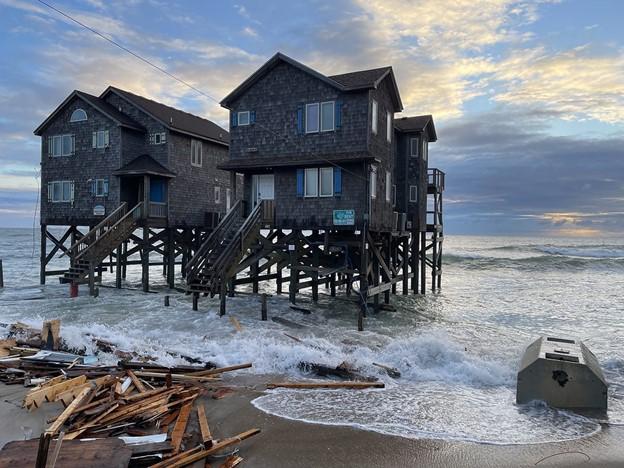 Science panel applies 2022 sea level report projections to NC
Science panel applies 2022 sea level report projections to NC
The science panel that advises the state Coastal Resources Commission is showing with a new report how the findings of a 2022 federal-level report projecting that sea levels will rise by more than a foot by 2050 apply to North Carolina. Released in mid-October, the “North Carolina 2024 Sea Level Rise Science Update” is the product of the science panel following the commission’s 2022 charge to present any new or significant data and research on sea level rise projections. The commission was put in place in 1974 when the North Carolina General Assembly adopted the Coastal Area Management Act, or CAMA. The 13-member commission designates areas of environmental concern, adopts rules and policies for coastal development within those areas, and certifies local land use plans. The state Department of Environmental Quality’s Division of Coastal Management staff enforces the commission’s rules. The U.S. Sea Level Rise and Coastal Flood Hazard Scenarios and Tools Interagency Task Force wrote “Global and Regional Sea Level Rise Scenarios for the United States,” that was published in February 2022 by the National Oceanic and Atmospheric Administration. Among the task force members are scientists from NOAA, NASA, the U.S. Geological Survey, Federal Emergency Management Agency, Army Corps of Engineers, Department of Defense and Environmental Protection Agency. “In recent years, confidence regarding the expected amount of sea level rise by 2050 has increased,” the science panel recaps from the 2022 technical report in its October 2024 update. Regardless of how much warming occurs by 2100, trajectories evaluated by the 2022 sea level rise technical report indicate sea level rise of 1 foot to 1.4 feet by 2050, relative to sea level in 2000. “The actual amount will depend on future greenhouse gas emissions, and how much ice is lost from the Greenland and Antarctic ice sheets,” the science panel continues in its update. “Projections for sea level rise beyond 2050 are less certain because they depend even more strongly on future greenhouse gas emissions and rate of ice loss from Greenland and Antarctica. However, rates of sea level rise are expected to further increase toward the latter half of this century.” On the science panel, Dr. Reide Corbett is the dean and executive director of the Integrated Coastal Programs at the Coastal Studies Institute on the East Carolina University Outer Banks Campus. He told Coastal Review that sea level rise projections continue to improve as new data becomes available and as the scientific community gains a better understanding of global processes changing sea level on different spatial and temporal scales. The state’s science panel used the best available and most recent data to provide this 2024 Sea Level Rise Update, Corbett continued, adding that “It is critical that our communities are working with the most informed projections as they develop actionable plans for building more resilience across our coast.” The strongest and most significant message Corbett said he sees coming from the 2024 update and other recent reports is that North Carolina must plan for at least a 1 foot rise in sea level by 2050. There is little deviation in this value whether projecting from tide gauges or using numerical models, Corbett added “This is a reality that we need to start planning for today,” he said. “A 1 foot rise in sea level will significantly increase the number of days coastal North Carolina will experience high tide flooding. Communities need to start building these challenges into their land use plans, stormwater plans, and communicating the risks to residents.” Division of Coastal Management Director Tancred Miller explained to Coastal Review that the science panel is defining sea level rise as an increase in the average height of the sea with respect to a specific reference. Relative sea level is the combination of three primary factors: the global sea level, vertical land movement and oceanographic effects. These parameters are usually discussed in terms of their rates of temporal change, commonly expressed in millimeters per year, he said. “Along the North Carolina coast, sea level is rising and the rate of rise varies depending on the location. There are two primary reasons for this variation along different parts of our coast: vertical land motion and the effects of ocean dynamics,” Miller continued. He explained that this recent update emphasizes that tide gauge observations and modeling for all scenarios are nearly the same out to 2050, “indicating we are solidly on track for at least one foot of sea level rise by 2050.” Miller noted that 2050 is just 25 years from now. “To prepare for this, requires community involvement, planning, mitigation, and adaptation to start now,” Miller said. To help better plan for sea level rise, the Coastal Resources Commission charged its science panel in 2022 with providing periodic updates to support what it called “informed planning and decision making.” The charge includes a request for the science panel to review every year any “new and significant scientific literature and studies that address the range of implications of sea level rise at the State, sub-regional, and local scales.” If there’s enough new information to warrant an update, the panel is to present these findings to the commission. Miller said for the science panel to follow through with the directive, the team of scientists held a series of meetings earlier this year to share and discuss any recent data related to sea level rise. “Given that the painstaking work of preparing sea level rise projections based on the latest science has already been carried out” by the task force, the science panel recaps the key messages detailed in the 2022 technical report. The science panel also gives a brief summary of the regional sea level rise projections most relevant to North Carolina and provides updated sea level rise projections and assessment of high-tide flooding frequencies for Duck, Beaufort and Wilmington, all based on data from the 2022 technical report. The science panel sent out a draft of the sea level rise science update for comment this spring. The document underwent a handful of changes based on public feedback, including the addition of a paragraph listing some of the key impacts of sea level rise, and adding the names of the different scenarios in the 2022 technical report — low, intermediate-low, intermediate, intermediate-high, and high — and referred to these throughout for clarity. “The five sea level rise scenarios span the range of sea level rise that can be expected under the emissions and warming scenarios considered in the Intergovernmental Panel on Climate Change Sixth Assessment Report,” or IPCC, the science panel states in its update. The IPCC was created by the United Nations to assess climate change-related science. “We also added text to explain how these scenarios relate to the emissions pathways and warming scenarios used in the Intergovernmental Panel on Climate Change report,” the new update continues. And provided more detail on the longer-term scenarios out to 2100. The science panel did note in its update that, although summarizing the latest science on how these impacts will affect the state “is well beyond the scope of the Sea Level Rise Update Charge to the Science Panel, we refer interested parties to the coastal aspects of the 2020 Climate Risk Assessment and Resilience Plan, and associated or similar documents (and updates), for a more comprehensive discussion of sea level rise impacts, based on the latest science, to facilitate effective adaptation and mitigation planning.” The first report the science panel, along with six additional contributors, issued was in March 2010 titled “North Carolina Sea Level Rise Assessment Report,” at the direction of the commission. The science panel recommended the report be reassessed every five years. In April 2012, the panel issued a follow-up addendum to the report in response to questions from the commission. That report was met with pushback from certain groups, resulting in a June 2012 law that put restrictions on how the sea level data was collated and used by state agencies and local governments. The panel released an update in 2015 of the 2010 report. “The next update was scheduled for 2020. However, due to the COVID pandemic, the 2020 update was postponed. In 2022, the CRC issued a revised charge to the science panel,” Miller said. The division continues to accept public comments on the newly released update. Send comments to DCMcomments@deq.nc.gov. List “2024 Sea Level Rise Science Update” in the subject line. “Comments regarding the final report simply serve as an opportunity for citizens to provide thoughts on the finished work and will be provided to the panel for review,” Miller said.
Read more » click here

Flood Insurance Program
For more information » click here

National Flood Insurance Program: Reauthorization
Congress must periodically renew the NFIP’s statutory authority to operate. On September 26, 2024, the president signed legislation passed by Congress that extends the National Flood Insurance Program’s (NFIP’s) authorization to December 20, 2024.
Congress must now reauthorize the NFIP
by no later than 11:59 pm on December 20, 2024.

GenX
For more information » click here

Homeowners Insurance
For more information » click here
As a hearing looms, here’s where talks over a massive 99% coastal insurance rate hike stand
Insurers want to raise homeowners insurance premiums by 42% statewide and an eyewatering 99% in beach and coastal areas around Wilmington. State regulators have said no, triggering an Oct. 7 hearing
Negotiations between state regulators and insurance companies over a potentially massive rate increases for North Carolina homeowners are going down to the wire. In January the N.C. Rate Bureau, a 14-member board that represents the industry, submitted a proposal to raise homeowner insurance premiums by 42% statewide and an eyewatering 99% in beach and coastal areas around Wilmington. The proposal, after a public hearing, was swiftly and vocally rejected by N.C. Insurance Commissioner Mike Causey. “I heard from more people on this rate filing than any other while I’ve been commissioner,” Causey, who has been in office since 2017, said on Thursday, adding his agency received more than 25,000 comments − almost all of which were against it. “And I agreed with them.” The commissioner’s action triggered a judicial hearing, which is scheduled for Oct. 7.
As that hearing grows closer, here’s where things stand.
Why do the insurance companies want such a big rate increase?
In short, because they aren’t making money and are worried about the future. The N.C. Rate Bureau cited two main factors for the surprisingly large rate increase proposal. First, is the rising cost of pretty much everything, including labor and potential repairs, driven by inflation and the lingering impacts of labor and material shortages tied to the COVID-19 pandemic. The other is climate change, which is causing more frequent and widespread property destruction, particularly tied to bigger and stronger hurricanes, as the warming climate fuels more severe weather events. Damages in North Carolina tied to 2018’s Hurricane Florence, for example, were estimated to top $22 billion, with much of that hitting inland areas. Other factors that are playing a role in the proposed substantial increase include the moratorium that was put into place during the pandemic on any rate increases and the cost of reinsurance − basically insurance for the insurance companies themselves in case a large-scale disaster stretches their financial ability to respond. “It will be four years in November since we last requested a homeowners rate increase, and even the approved change was only a small percentage of what was requested,” said Jarred Chappell, chief operating officers with the rate bureau, in an email. “That has been the case over multiple rate filings, which has contributed to the ongoing rate need.”
Why can’t the insurance companies just raise rates?
North Carolina operates a regulated insurance market. That means that companies have to receive approval from state regulators to raise most rates, including those for homeowner and auto insurance. While some in the industry have said that limits competition in a somewhat closed market and doesn’t make North Carolina an attractive market for insurance companies, Causey disagrees. He said the current system, which attempts to balance the needs of consumers and industry, offers some security for both sides and somewhat ring fences North Carolina from seeing the problems other coastal states, like Florida and Louisiana, are experiencing. In those states, many insurance companies are pulling out in the wake of repeated natural disasters and an inability to charge rates they believe reflect their liability and ability to turn a profit. That, in turn, is forcing the state to create government-run insurance companies of last resort for folks who otherwise can’t get coverage, which generally offer higher premiums and less coverage to balance their books.
Do proposed rate increases always end up in a hearing?
Generally, no, because that costs both the state and industry time and money that they’d rather not spend. Causey, a Republican who is running for re-election this November against Democrat Natasha Marcus, said in most rate disputes his department and the rate bureau have been able to negotiate before a hearing date and reach a mutually acceptable agreement. “We have done that very successfully in the past and get settlements that are mostly favorable to consumers,” he said. That hasn’t happened in this case. “We are at an impasse,” Causey said. “We’re going to court.”
What happens at the Oct. 7 hearing?
State law gives the insurance commissioner 45 days to issue an order once a hearing concludes, and the insurance industry always has the option of taking the issue to the courts if they reject the commissioner’s findings. Causey said he understands that the industry needs a rate increase, not having seen one since the start of the decade. “And like consumers and every industry, they’re getting hit by inflation,” he said. “It’s no different than any other industry or business.” But Causey said an average statewide increase of more than 40%, and double that at the coast, just isn’t fair to North Carolina consumers. “North Carolina consumers deserve a more thorough review of this proposal,” Causey said in a statement in February announcing his rejection of the proposed rate hike. “I intend to make sure they get that review.” But whatever happens with this rate hike, that’s not likely to be the end of the financial pain for coastal homeowners. Causey said this request is mostly tied to the industry’s costs and payouts associated with the spate of natural disasters, including 2018’s Hurricane Florence, North Carolina saw several years ago. He added that his office is still dealing with claims tied to Florence, having recently paid one out to the University of North Carolina Wilmington (UNCW) tied to that devastating storm. “It takes years from the time a storm hits for the rates to catch up,” Causey said. That means damage from this month’s unnamed storm, which dropped historic amounts of rain on parts of the Cape Fear region, and losses associated with Tropical Storm Debby and any from Hurricane Helene aren’t taken into account with this rate filing. “If we could get Mother Nature to cooperate, we wouldn’t have many of these problems,” he said of the natural disasters, many tied to climate change, which have hit the state in recent years. “But that’s just not the case.”
Read more » click here
After Floods, Soaring Insurance Rates Become a Hot Election Issue
Few states elect their insurance commissioners. But in North Carolina, a proposed 42 percent rate hike and Hurricane Helene have raised the stakes in the upcoming election.
When Marjorie Burnside moved to the North Carolina coast several years ago after retiring as a New York City police officer, she did not know much about the candidates running for the obscure statewide offices that oversee agriculture, labor, and insurance. So, Ms. Burnside, a lifelong Republican, voted along party lines. She now considers many of her area’s elected Republicans responsible for rubber-stamping too many development projects. And she is furious that they have failed to tame home insurance premiums, which have soared by 75 percent. That was why she accepted an invitation to a friend’s recent beach house party for State Senator Natasha Marcus, a Democrat who is challenging the state’s Republican insurance commissioner. “She just gave me lots to think about,” Ms. Burnside, 59, said after listening to Ms. Marcus’s warnings about loopholes that hurt policyholders and rates in coastal areas that are likely to see a significant rise. “More people, more claims, more raises — it’s all connected.” Eleven states elect their insurance commissioners, an obscure but powerful job that affects virtually every resident through regulations and the ability to challenge or reject rate hikes on home, car and other policies. The contest has typically been treated as a down-ballot afterthought involving little-known candidates, with hundreds of thousands of voters leaving their ballots blank. But as housing and insurance costs have skyrocketed, particularly in areas experiencing whiplash from climate change and extreme weather, these races are becoming proxies for public frustration over pocketbook anxieties. “Voters are starting to experience climate change as an economic threat, and are realizing that insurance commissioners are now climate policymakers,” said Jordan Haedtler, a climate finance strategist for Climate Cabinet, which supports candidates in competitive races nationally. Insurance angst has already factored into local elections this year: In Honolulu, State Representative Scott Saiki, Hawaii’s House Speaker since 2017, lost his Democratic primary amid criticism that he had failed to rein in condo insurance rates. In Orlando, a Democrat won a special election for a state House seat by highlighting property insurance, flipping a district that Gov. Ron DeSantis of Florida easily won in 2022. Now comes the biggest statewide test, where recent polls in North Carolina — the most competitive of the four states voting for insurance commissioner in November — predict a tossup between Ms. Marcus and the two-term incumbent, Mike Causey. The timing also could not be more relevant, given the devastation wrought by Hurricane Helene in western North Carolina and Tropical Storm Debby. Claims totaling billions of dollars are likely to be filed. “In general, it feels as though the incumbent has a bit of a challenge or a hurdle to get over in that rates have steadily gone up, and right, wrong or indifferent, a consumer can point to an incumbent and say you’re not doing enough to fix that,” said Landon T. Bentham, director of sales and marketing for Callahan & Rice, a longtime independent insurance agency in Fayetteville, N.C. North Carolina has long been regarded as one of the more stable states for insurance, for both policyholders and carriers. Auto insurance rates are among the nation’s lowest. The state’s nonprofit insurer of last resort — a tax-exempt association of insurance companies that are required by law to insure properties and spread the risk — had enough cash to pay $1.5 billion in wind and hail claims after Hurricane Florence ravaged the state in 2018. But in 2023, Nationwide decided not to renew 10,000 homeowners’ insurance policies in eastern North Carolina, citing climate and other reasons. Overall, the average home insurance premium in the United States climbed by 33 percent from 2020 to 2023, far exceeding inflation, according to a new study, and some insurers are no longer writing policies in Florida, California and Louisiana. So far, at least, “no big insurer has left the state,” said Donald T. Hornstein, a law professor at the University of North Carolina School of Law, who has lectured on coastal insurance concerns. But while insurers have seen profits in 10 out of the last 11 years in North Carolina, they lost money in 18 other states in 2023, up from eight in 2013, according to an analysis by The New York Times. Against that backdrop, the North Carolina Rate Bureau, a nonprofit consortium of insurers empowered by the State Legislature to calculate adjustments in premiums, requested a 42 percent increase in January — including 99 percent in some coastal areas — citing inflation and increased costs for materials and labor. Since then, 40,000 emails, phone calls and letters have inundated the Department of Insurance, which, as the state’s regulator, must approve any increases. Mr. Causey, a former health insurance executive, has preferred to negotiate the policies affecting the state’s housing stock. In May, he negotiated an 8 percent increase in the rate that applies primarily to rental properties, down from an original request of more than 50 percent. In 2020, the last time homeowners’ insurance rates were increased, a 24.5 percent request was whittled down to 7.9 percent. But Mr. Causey rejected this year’s proposal to increase homeowners’ insurance rates by 42 percent, setting the stage for his first public judicial hearing on rate hikes on Oct. 7. “I very much understand where the people are coming from because we’re all paying higher insurance rates, and inflation is the driving factor that’s hurting all Americans,” Mr. Causey, 74, said in an interview a few weeks before the hearing. But Ms. Marcus has been on the attack, accusing Mr. Causey of approving too many rate increases without holding public hearings. She talks about a little-understood Consent to Rate law — which was amended by the Legislature in 2018, with Mr. Causey’s input — being used increasingly by insurers in North Carolina to charge homeowners more than the rates approved by the state. While Mr. Causey has often worked closely with his fellow Republicans who have long dominated the Legislature, he sided with Gov. Roy Cooper, a Democrat, on energy efficiency and resiliency in homes, and opposed a bill backed by Republicans to prohibit any updates to building codes until 2031. In the wake of Helene, Mr. Causey has renewed his calls for a statewide expansion of the last-resort insurer for vulnerable coastal properties. Ms. Marcus says that the state needs to invest more in hardening homes, and that flood maps are woefully outdated. Much of Helene’s damage was caused by flooding, and few people in western North Carolina had taken out federal flood insurance, which is not within the purview of the state insurance commissioner. Still, the storm was clearly on the candidates’ minds on Monday, when Mr. Causey and Ms. Marcus held separate news conferences before the rate increase hearing. The proposed rate hikes, which were requested at the beginning of the year, were much lower in western North Carolina than along the coast. So, when asked whether Helene would be a factor in future insurance-rate increases, Mr. Causey said, “It very well could be.” But he also cautioned that it was too early to know. “We’re just now seeing impacts from Hurricane Florence, and that was back in 2018, so we have to wait and see how it shakes out,” he said. Part of an insurance commissioner’s job is to visit storm-hit areas and set up victim assistance centers to help residents with insurance claims and other needs. A few weeks before Helene, Mr. Causey visited North Carolina’s southeastern coast — on the opposite end of the state from where Helene hit — after a storm unexpectedly dumped as much as 18 inches of rain there. In the fast-growing but risk-prone counties of Brunswick, New Hanover and Pender on the southeastern coast, homeowners now pay an average of roughly $3,100 a year on insurance, or up to 67 percent more than other counties in risk-prone areas. Paul Cafasso, a retired I.T. executive from the Danbury, Conn., area, is part of a wave of retirees from the Northeast who have moved to a sprawling development in Brunswick County, where the number of people aged 65 or over more than doubled between 2010 and 2020. A political independent, Mr. Cafasso, 81, said his community’s condo association had seen its insurance costs double in the last two years, forcing the association to switch to another carrier. So, he intended to research each candidate’s plans. “On a bell curve, we’re on the upward part of the bell curve — who knows where it’s going to end?” he said. During a tour of his farm, Jimmy Tate, a former Pender County commissioner and community college president, said more people, crushed by escalating premiums, are agonizing over whether even to take out insurance. A former Democrat who is now a Republican, Mr. Tate, 46, wants the two candidates to hold corporate interests accountable, and to visit rural and underserved communities. “If they really want to care, they can come on my farm and I can hold a meeting in my event barn center,” he said. “I can guarantee them I can pack the room with farmers, all over this region, who want to hear what they have to say about their rate increases.” Known for uncorking fiery speeches on the Senate floor, Ms. Marcus, 55, was gerrymandered out of her district by Republicans, who hold the supermajority. She opted to run for commissioner rather than move to another area to run again. In an interview, she said her experience as a lawyer would enable her to adopt a more adversarial posture when dealing with the insurance establishment. “I’m a former litigation attorney — very comfortable in a court-like setting, eager to do that kind of cross-examination,” she said. Refusing to take campaign contributions from the insurance industry, in contrast to Mr. Causey, Ms. Marcus has raised more than $427,000, nearly double her opponent’s haul. Mr. Causey has been a visible presence all over the storm-ravaged state, warning about the future. At a meeting with insurance agents in the Outer Banks, where homes have been collapsing into the ocean as a result of rising sea levels, Mr. Causey voiced his frustration with the state’s building codes. “In 2017, we were the fifth best in the nation in building codes,” he said. “We’ve dropped to number eight. We’re going the wrong way.”
Read more » click here
NC coastal insurance rates are going up, but by how much is still to be determined
Insurance companies want to raise homeowner insurance rates by 42% statewide and nearly double them around Wilmington’s coastal areas. The state is challenging the proposal.
While several major questions about the country’s future were decided on Election Day, many residents in the Wilmington area are waiting for another big decision to come down. But how much North Carolina’s homeowner insurance rates might go up, especially at the coast, is still to be determined more than 10 months after a proposal by state insurers that could see some premiums double in price. A hearing to review a request by the N.C. Rate Bureau, a 14-member board that represents the industry, to raise homeowner insurance premiums by 42% statewide and an eyewatering 99% in beach and coastal areas around Wilmington, started in early October. The hearing was triggered after N.C. Insurance Commissioner Mike Causey rejected the initial proposal, calling it too much. State law gives Causey 45 days to issue an order once a hearing concludes, and the insurance industry always has the option of taking the issue to the courts if they reject the commissioner’s findings. But the hearing has yet to wrap up, and the court is on hiatus this week. With the hearing likely to wrap up around mid-November, several officials said it could be next month − potentially just before the new year − before Causey makes a decision, with any changes to rates likely not effective until mid-2025. That’s because of the complexity of the case, but also because this is an election year, and Causey was up for re-election in a heated campaign against Democrat Natasha Marcus, who has blamed Causey for giving in too easily to the industry when it comes to raising insurance rates. North Carolina is a regulated insurance market, meaning companies have to receive approval from state regulators to raise most rates, including those for homeowner and auto insurance. Causey has said he has fought hard since taking charge of the state insurance office in 2017 to keep rates down. But having not had a rate increase in more than four years, and a pandemic and several natural disasters in between driving up repair costs and prompting large insurance payouts, even Causey admits the industry deserves the chance to raise rates. But the rub is by how much, with officials worryingly noting that the current rate request doesn’t include the damages from this year’s Hurricane Debby, an unnamed storm that slammed the Wilmington area in mid-September, and the devastating floods from Tropical Storm Helene in Western N.C.
No settlement this time around
In many past rate disputes, the insurance department and industry have been able to negotiate a settlement before the issue reached the courts. In the 2020 homeowners filing, for example, the rate bureau requested an average 24.5% increase but settled with the state on 8%. That the parties haven’t been able to reach a deal this time around shows just how much is at stake this time around. For N.C. homeowners, it is a pocketbook issue. But for Causey and the state as a whole, it’s about maintaining a healthy and attractive market for insurance companies to ply their trade. Push too hard, and North Carolina could find itself in a similar position to Florida and Louisiana, where repeated hurricane hits and an inability to charge premiums to cover their exposure have seen many insurance companies flee those states or go bankrupt. That has prompted both states to set up government-run programs as “insurers of last resort” for homeowners who don’t have any other options. But that, in turn, has put all of the state’s taxpayers on the hook if a major natural disaster strikes. A major factor driving the insurance industry’s desire to significantly increase rates − which is quickly becoming a national and global issue − is the increased size and frequency of natural disasters in recent years, which almost everyone is tying to climate change. Insurance companies themselves aren’t immune to the increased costs associated with ever-more frequent and expensive natural disasters, which include hurricanes, floods, wildfires, heatwaves and droughts, with the cost of reinsurance − effectively insurance for insurance companies − increasing dramatically in recent years, doubling in some cases. Munich Re, one of the world’s largest reinsurers, has said “the insurance industry is directly affected by the consequences of climate change.” “In recent years, tropical storms (called hurricanes, typhoons or cyclones depending on the region where they occur) have been accompanied by increasingly extreme precipitation,” the German-based company states in a report discussing climate change and its consequences. “There are also indications that the proportion of especially severe storms is rising.”
New Hanover County tops the NC risk list
The Federal Emergency Management Agency (FEMA) also has sounded the alarm about the rising risk to many areas posed by the increased risk of natural disasters as the world warms and weather patterns become more unpredictable. The agency has created a National Risk Index to help residents and businesses determine a community’s risk factors. It also allows parties to compare and contrast risks between communities. Not surprisingly, the index shows the most risk-prone areas of North Carolina are at the coast. Unfortunately for Wilmington, FEMA says New Hanover County is the riskiest county of all in North Carolina. The county was rated “very high” for the risk of ice storms and lightning strikes, and “relatively low” for earthquakes. But it was the threat of hurricanes that pushed New Hanover’s risk score up, with the county rated as “very high” for threats from tropical storms. The FEMA risk index states that New Hanover has about a 40% chance of dealing with a hurricane in any given year, with an average annual loss of nearly $267 million. On the plus side, the index says New Hanover, Brunswick and Pender counties are safe from avalanches, a cold wave, landslides, volcanic activity, and tsunamis.
Read more » click here
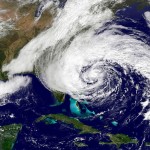
Hurricane Season
For more information » click here
Hurricane season runs from June 1 through November 30.
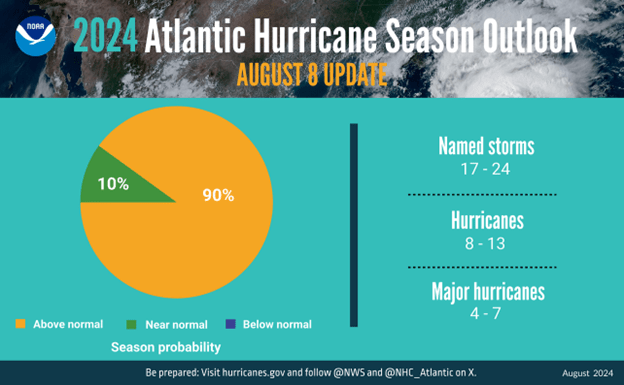
Hurricane season isn’t over yet.
Here’s why North Carolina residents need to stay vigilant.
Despite tropical storm-induced flooding in the mountains and along the coast, experts say NC isn’t out of the woods yet as hurricane season drags on
First Tropical Storm Debby, a slow-moving storm that trudged up the East Coast in early August before making a second landfall along the central South Carolina coast, drenched the Cape Fear region with more than 15 inches of rain in places. A little more than a month later, an unnamed storm that wasn’t deemed a big enough threat to close many schools swamped parts of southern New Hanover County and much of Brunswick County with another massive deluge. The nearly 20 inches of rain in some areas caused extensive flash flooding, collapsed roads, and destroyed several bridges. Then Tropical Storm Helene blew into the state three weeks ago, pummeling Asheville and the North Carolina mountains. The record-setting rainfall, more than 18 inches in some places, washed out roads and bridges, knocked out power to nearly 2 million people in the Carolinas − with 14,000 N.C. customers still without power as of Wednesday, and killed at least 95 people in the state with dozens still unaccounted for. North Carolina has been hammered on both ends of the state by tropical weather systems this year, making 2024 one of the worst hurricane seasons the state has seen in a long time. And while it might be mid-October and temperatures are already beginning to fall, experts warn that the Tar Heel State needs to stay on alert for another possible visit from Mother Nature. Several factors are contributing to officials’ concerns, but chief among them is the impact climate change is having on temperatures and weather patterns. “So, no, we are definitely not out of the woods for this season,” said Dr. Michael Mann, a meteorologist and scientist at the University of Pennsylvania, in an email.
Does North Carolina get late-season hurricanes?
On Oct. 15, 1954, Hurricane Hazel made landfall near the North Carolina/South Carolina state line. The storm remains the only Category 4 hurricane to ever hit the Carolinas. After wiping clean some of the Brunswick County barrier islands with storm surge that exceeded 18 feet in places, the monster storm barreled inland at speeds of more than 50 mph. That allowed Hazel to bring hurricane-force winds well inland, to places like Fayetteville, Raleigh and Goldsboro. While Hazel might be a bit of an outlier, it isn’t the only storm that has impacted North Carolina late in hurricane season. Others include 2012’s Hurricane Sandy, which brought substantial overwash to the Outer Banks and nearly a foot of snow to the N.C. mountains in late October, and 2018’s Tropical Storm Michael that left more than 400,000 without power and flooded many coastal communities. Hurricane Matthew also hit the state in October 2016, flooding nearly 100,000 structures across much of Eastern North Carolina and causing billions in damages. Remnants of tropical systems that form and then fall apart farther south also can wander north and impact parts of the state, especially coastal areas as they ride the Gulf Stream north.
How is the rest of the 2024 hurricane season shaping up?
As of Wednesday, the National Hurricane Center was tracking two tropical disturbances in the Atlantic basin, with the one in the mid-South Atlantic on track to hit the northern Caribbean and then potentially Florida. If it strengthens enough, it would become Tropical Storm Nadine. They are unlikely to be the last systems of the season to attract the attention of meteorologists. Before hurricane season officially began June 1, officials were expressing concern over how bad it might be. With climate change warming the oceans and air temperatures seemingly hitting new highs every month, they said it really was only a question of just how brutal the season would be. But for most of the summer, aside from Beryl, which was a rare major June hurricane, the reality on the ground seemed to confound the predictions, with Saharan dust blowing off Africa helping limit storm formation for much of June, July and into August. Then Debby, Ernesto, Francine and Helene came barreling ashore − not to mention the no-name storm that pummeled Southeastern North Carolina. Mann said conditions remain ripe for more storm activity. He said sea surface temperatures remain very warm, largely a result of heat-trapping gasses pumped into the atmosphere tied to human activity. Warmer ocean water helps fuel storms, allowing them to intensify more quickly and grow bigger and stronger. They also can hold their strength longer and travel farther inland, and hotter ocean temperatures allow them to travel farther north, striking areas that aren’t used to seeing raging hurricanes on the horizon. Mann said we’re also still transitioning toward a La Niña climate pattern. That will mean decreased wind shear in the tropical Atlantic and a more favorable environment for tropical cyclones. “That combination of factors tends to lead to very late seasons,“ Mann said. “2005 is the definitive example, where we saw named storms into the new year.” The record-setting 2005 hurricane season included 28 named storms and 15 hurricanes. Four of those reached Category 5 strength, and seven of the storms formed in October, another three in November. Although hurricane season is supposed to end Nov. 30, the 2005 season continued until Jan. 6 and was so busy the National Hurricane Center had to use the Greek alphabet to name some of the storms. Infamous storms from that season included Hurricanes’ Katrina, Rita and Wilma. Another storm, Hurricane Ophelia, raked much of the N.C. coast, causing significant coastal flooding and erosion.
Read more » click here
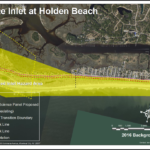
Inlet Hazard Areas
For more information » click here
.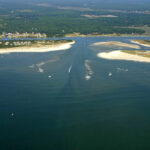
Lockwood Folly Inlet
For more information » click here.

Seismic Testing / Offshore Drilling
For more information » click here.

Offshore Wind Farms
For more information » click here
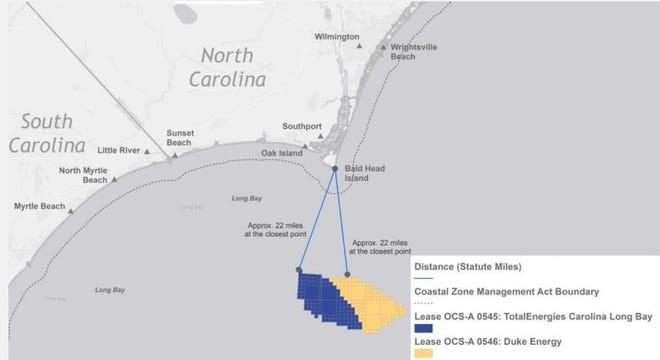 11 things to know about offshore wind farms in North Carolina and the United States
11 things to know about offshore wind farms in North Carolina and the United States
There are currently three offshore wind farms proposed for the N.C. coast, including two off Brunswick County.
After a few industry hiccups, the proverbial winds seems to be blowing back in the right direction for offshore wind projects that the Biden administration and many states, including North Carolina, are relying on to help them tackle carbon emissions from their power sectors.
Among the offshore wind projects on the drawing board are three wind farms off the coast of North Carolina, including a pair roughly 20 miles south of Bald Head Island in Brunswick County.
Here are 11 facts and tidbits to know about the Brunswick projects and offshore wind farms in general.
- In 2022, TotalEnergies Renewables USA and a Duke Energy subsidiary paid the federal government a combined $315 million to lease nearly 140 miles of ocean off Brunswick County for a pair of huge wind farms. The projects are currently in the very early stages of planning and survey work.
- If the Brunswick wind farms are fully developed, which would occur sometime in the early 2030s, the projects could produce nearly 2.4 GW of power, enough to supply 750,000 homes.
- In 2021, Gov. Roy Cooper signed an executive order that doubled down on the state’s commitment to offshore wind power, with goals of 2.8 GW off the N.C. coast by 2030 and 8 GW by 2040 − enough to power roughly 2.3 million homes.
- The latest version of Duke Energy’s Carolinas Resource Plans, which includes carbon-reduction proposals for both North and South Carolina, includes plans to add 2.4 GW of offshore wind to its grid by 2035. The N.C. Utilities Commission is currently reviewing Duke’s proposed plan, with a decision expected by the end of the year.
- According to the National Renewable Energy Lab (NREL), Virginia, North Carolina, South Carolina, and Georgia have 82% of the East Coast offshore wind resource in shallow water and 45% of the total East Coast offshore wind resource.
- Currently the largest offshore wind farm under construction in the U.S. is being built by Dominion Energy 27 miles off the coast of Virginia. The project, which should be finished in about two years, is expected to generate 2.6 GW from 176 turbines.
- Offshore wind turbines are getting taller and taller. According to the U.S. Department of Energy, the average height of the hub − where the large, spinning blades are attached to the monopole − was about 330 feet in 2016. That is expected to increase to 500 feet, the height of the Washington Monument, by 2035. Add the height of the blades at their apex, and that increases to more than 800 feet.
- North Carolina is eager to capitalize on the economic opportunities offered by the growing offshore wind market. Efforts include the formation of the N.C. Taskforce for Offshore Wind Economic Resource Strategies (NC TOWERS).
- A 12-turbine wind farm off the Hamptons on New York’s Long Island became the first U.S. offshore wind project to provide power onshore when it was connected to the grid in December 2023.
- Despite significant federal incentives and strong political support, offshore wind has had a rough few years. Issues that have arisen include post-pandemic inflation spikes, rising interest rates, supply chain bottlenecks, and worries from coastal residents that huge turbines would ruin their “viewscapes.” Some Republicans and environmentalists also have raised concerns about the wind farms’ impacts on marine life, particularly whales.
- Compared to other countries around the world, the U.S. is a laggard in harnessing the energy potential of offshore winds. The top five countries, in descending order, generating electricity from offshore wind farms are China, the United Kingdom, Germany, the Netherlands, and Denmark.
Read more » click here
Update provided on offshore wind off Brunswick County coast
During the Oct. 23 Brunswick County Shoreline Protection Consortium meeting, representatives from one of the offshore wind lease holders for the Carolina Long Bay Wind Energy Area, located off the Brunswick County coast, provided an update on the project, while local officials and stakeholders pushed back on the plans. TotalEnergies, a French multinational energy and petroleum company, and Cinergy Corporation, a direct non-regulated Duke Energy subsidiary, won the May 2022 auction for lease of the 86 square nautical mile Carolina Long Bay Wind Energy Area (WEA), with TotalEnergies leasing 54,937 acres and Cinergy Corporation leasing 55,154 acres. If developed, the WEA could generate at least 1.3 gigawatts of offshore wind energy, enough to power nearly 500,000 homes. The Carolina Long Bay area encompasses much of the Brunswick County coast and extends into South Carolina past Myrtle Beach. The wind turbines will be located at least 22 miles from Bald Head Island’s shores and eight miles west of Frying Pan Tower, representatives confirmed during last month’s meeting. The turbines would be less visible as one moves further south down the county’s coast. The Brunswick County Board of Commissioners in 2021 adopted a resolution opposing offshore wind turbines sited fewer than 24 nautical miles from the shoreline. Several Brunswick County municipalities have adopted similar resolutions. During the Oct. 23 meeting, Representative Frank Iler asked if the turbines would be visible from shore. In response, Susan Munroe, TotalEnergies community engagement manager, said the turbines would be “minimally visible.” “The closer we get to development, we’re going to do some visualizations,” she said. “It’s going to be minimally visible depending on the time of day, depending on where you are.” Albie Solana, TotalEnergies’ fisheries liaison, noted the moisture in the air during the summertime in Brunswick County will further reduce visibility. Regarding a timeline for development and construction of offshore wind turbines there is still a “long, long, long way to go,” according to Munroe. Munroe explained that the North Carolina Utilities Commission (NCUC) will release its next order of the state’s carbon plan, originally adopted in 2022. The plan is a result of the ratification of House Bill 951 in 2021, which requires the NC Utilities Commission (NCUC) to take “all reasonable steps” to achieve 70% carbon emissions reductions from 2005 levels by 2030 and achieve carbon neutrality by 2050. “The [NC] Utilities Commission will release their next order of the carbon plan December of 2024,” she said, “and for us, for the project what that means is that they will provide some sort of direction.” Although TotalEnegeries or Duke Energy are not currently privy to what the updated order will call for, Munroe said the next major action on the Carolina Long Bay project would be installation of data collection buoys in the lease area. The Carolina Long Bay WEA was surveyed in 2023 to find “suitable” locations for the deployment of three data-collection buoys, The Brunswick Beacon reported. If approval for the buoys is granted, two will be used to collect meteorological data and one will be used to collect environmental data, namely for wildlife monitoring. Data will be collected over a one- to two-year period. Following the TotalEnergies presentation, local leaders pushed back on the plans for offshore wind development off the county’s coast, asking about the benefits the project will bring to Brunswick County, the municipalities and citizens versus the impacts. Brunswick County Commissioner Marty Cooke said the Carolina Lay Bay project is “being forced down our throats” by the Bureau of Ocean Energy Management (BOEM), North Carolina Governor Roy Cooper and the former Obama Administration, noting the county is not in favor of offshore wind development off its shores. “We don’t want these things anywhere near us, and if you’re going to have a 300-foot tall tower out there that’s 22 miles out or whatever, we’re going to see them,” Cooke said. Oak Island Mayor Elizabeth White pressed TotalEnergies representatives on how towns and citizens within the turbines’ viewshed will benefit from the project. “The benefits, I’m not hearing them being articulated — it’s all very vague at this point. … It’s hard to support something when we don’t know what it is we’re supporting other than visually offshore, but I can’t go back to my community and as the mayor say, ‘This is how our community will benefit from this project.’ We’ll pay the price for years,” White said. North Carolina For-Hire Captain Association Officer Cane Faircloth echoed Cooke’s sentiment, noting the organization, based on its independent research, feels the offshore wind industry is not being truthful and transparent about the effects of offshore wind projects. Munroe, in response to these comments, said they hear the various concerns “loud and clear” and will work to address them as the project moves forward. “We are so early in the process and I’m grateful for that,” she said. “We have a lot to learn. We have a lot of time to listen to concerns and learn.”
Read more » click here
Things I Think I Think –
 Eating out is one of the great little joys of life.
Eating out is one of the great little joys of life.
Restaurant Review:
The Dinner Club visits a new restaurant once a month. Ratings reflect the reviewer’s reaction to food, ambience and service, with price taken into consideration.
///// October 2024
Name: SmacNally’s
Cuisine: Seafood
Location: 1045B-Var Road, Supply NC
Contact: 910.842.9999 / https://www.facebook.com/people/Smacnallys-in-Holden-Beach/61559411716890/
Food: Average / Very Good / Excellent / Exceptional
Service: Efficient / Proficient / Professional / Expert
Ambience: Drab / Plain / Distinct / Elegant
Cost: $17 Inexpensive <=20 / Moderate <=26 / Expensive <=35 / Exorbitant <=60
Rating: Two Stars
The owners of SmacNally’s Waterfront Bar & Grill in Ocracoke have expanded and taken over the space at what was once known as Betty’s Waterfront Restaurant before reopening in 2020 as LouLou’s Waterfront Restaurant. They plan on implementing the same dock-to-kitchen model as much as possible, while also working with local markets for the freshest seafood possible. Relaxed indoor and outdoor waterfront dining on the Intracoastal Waterway with really nice views. Dinner only for the time being, and they have live music on some nights. Apparently they are experiencing some operational startup challenges. Their kitchen crew struggled with orders on a weeknight in October. I would not be in any hurry to try it until they can overcome those challenges.
Dining Guide – Local * Lou’s Views (lousviews.com)
Dining Guide – North * Lou’s Views (lousviews.com)
Dining Guide – South * Lou’s Views (lousviews.com)
Restaurant Reviews – North * Lou’s Views (lousviews.com)
Restaurant Reviews – South * Lou’s Views (lousviews.com)
Book Review:
Read several books from The New York Times best sellers fiction list monthly
Selection represents this month’s pick of the litter
 WE SOLVE MURDERS by Richard Osman
WE SOLVE MURDERS by Richard Osman
Osman author of the best-selling Thursday Murder Club mysteries launches a new series and introduces us to another lovable group of unwitting investigators. Amy is a private security officer, her father-in-law Steve is a retired police office, they have a special relationship. When a dead body and a bag of money turn up on a remote island, Amy reaches out to her retired father-in-law to help investigate and then embark on a globetrotting quest. The odd duo join forces to turn mystery-solving into a new family business.
That’s it for this newsletter
See you next month
Lou’s Views . HBPOIN
. • Gather and disseminate information
. • Identify the issues and determine how they affect you
. • Act as a watchdog
. • Grass roots monthly newsletter since 2008

